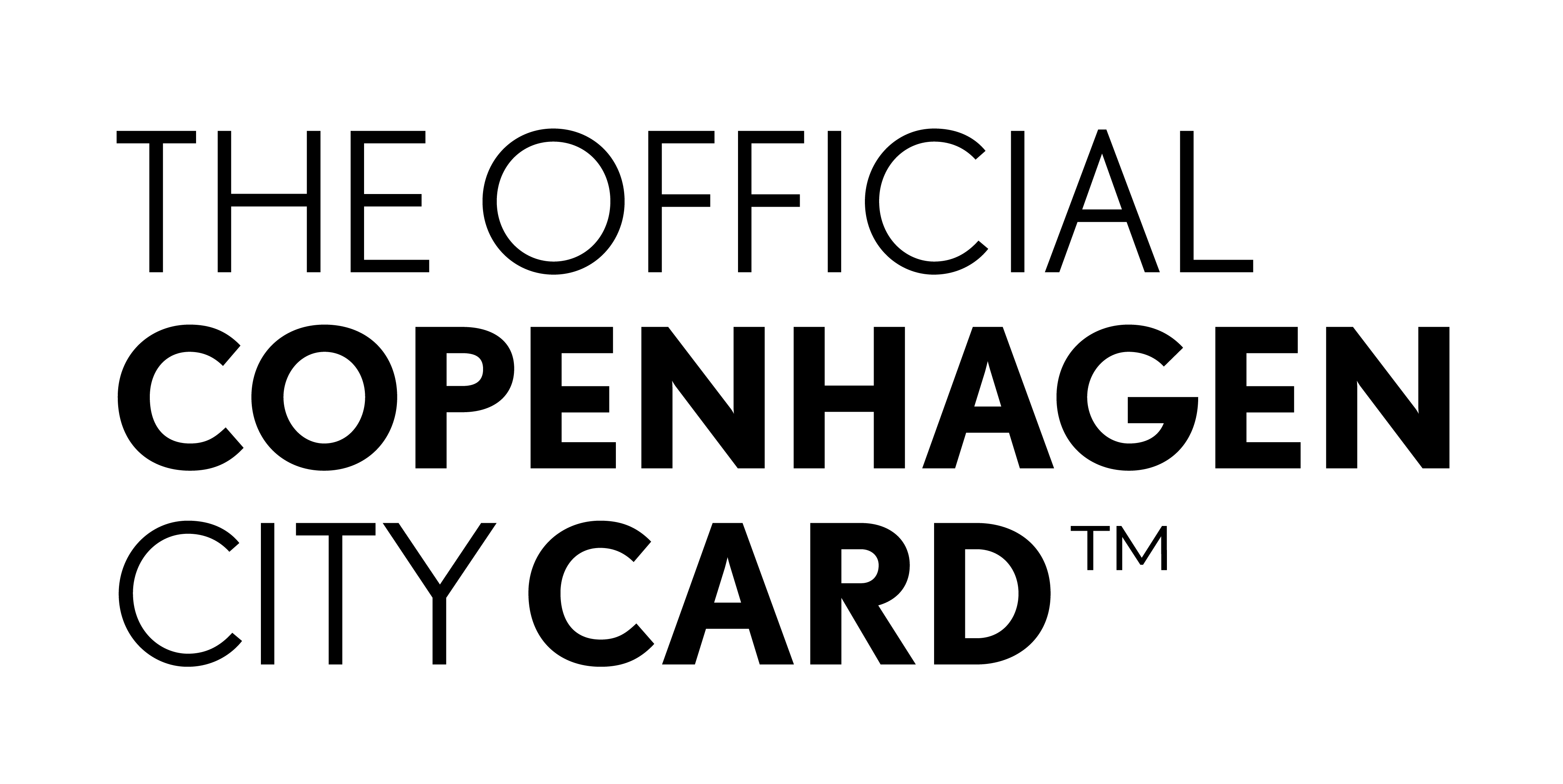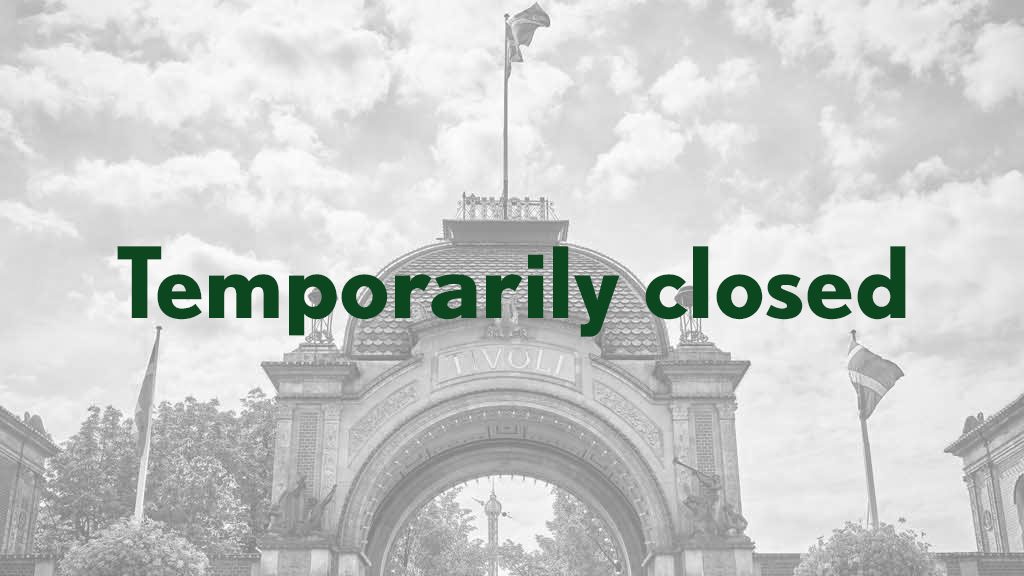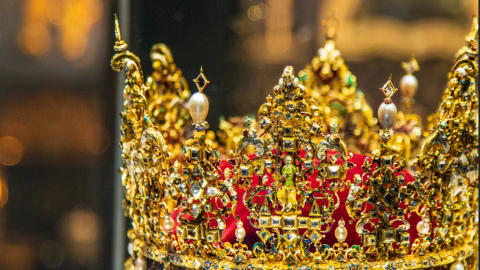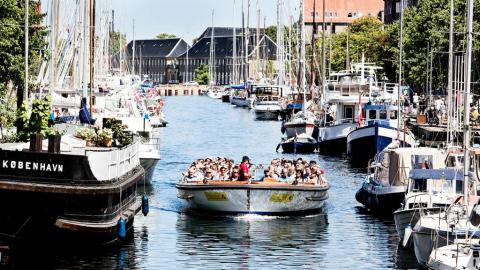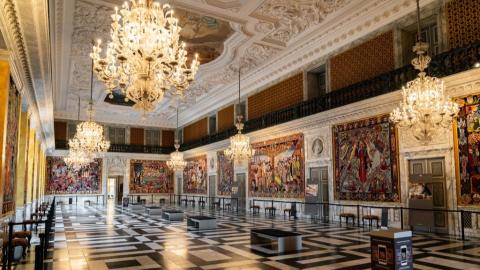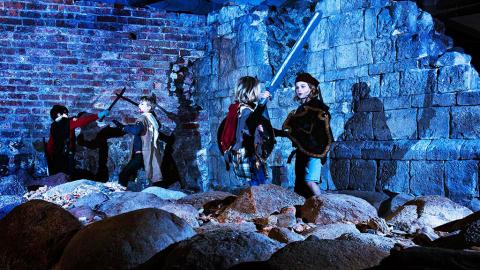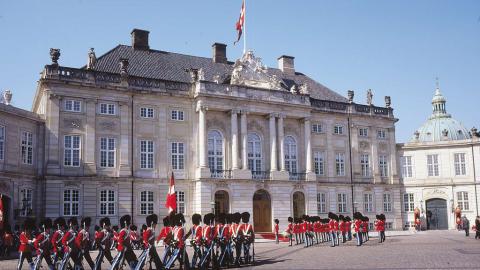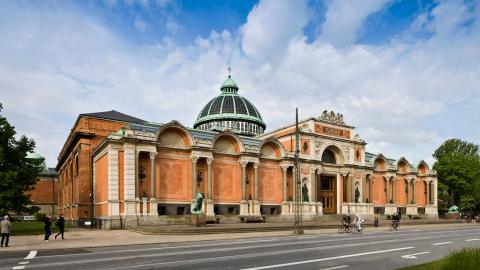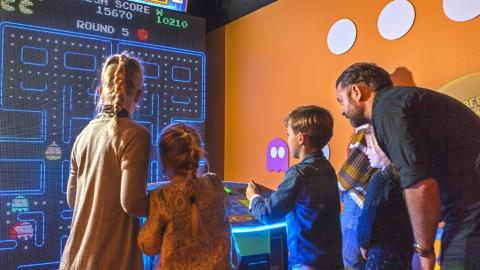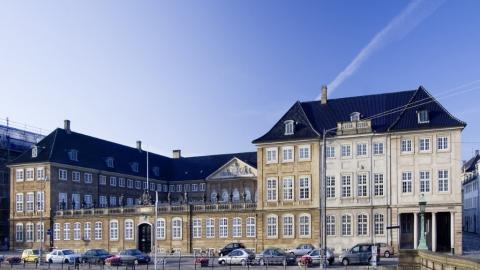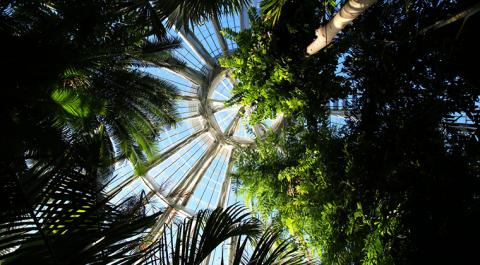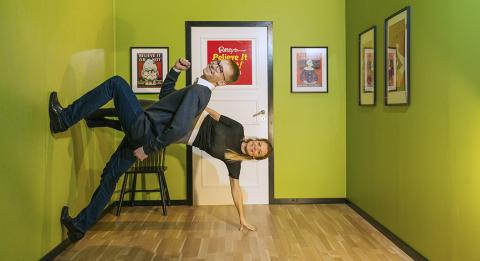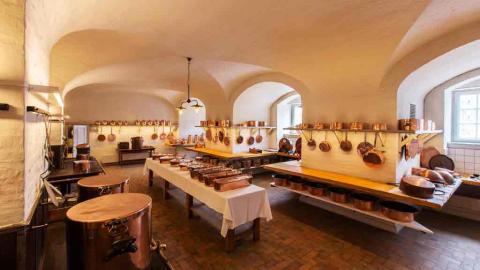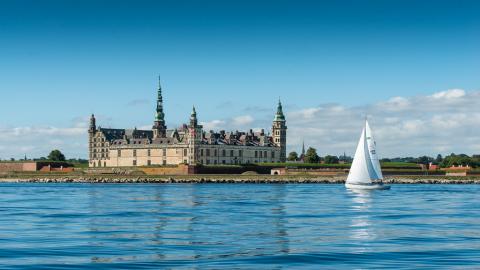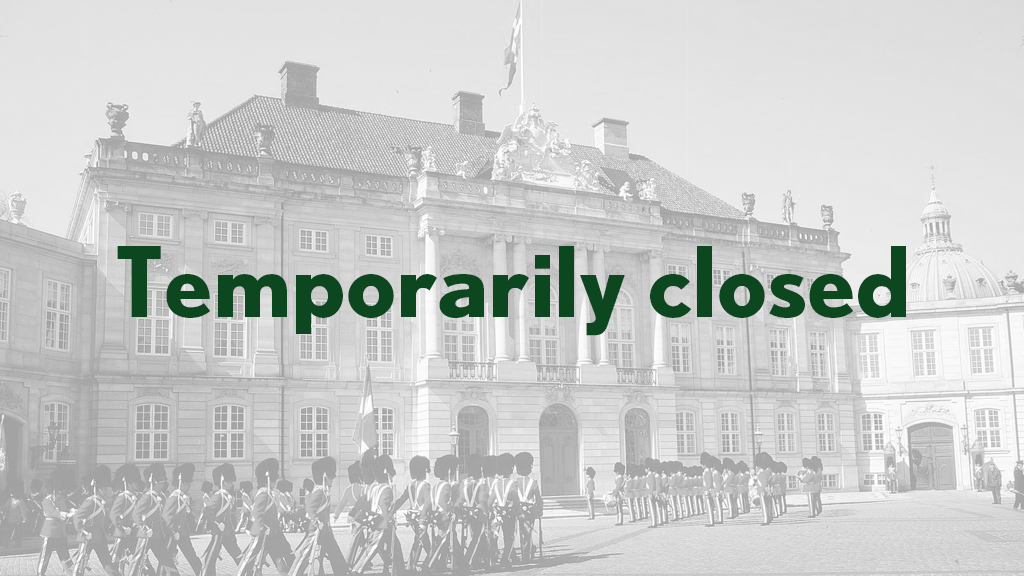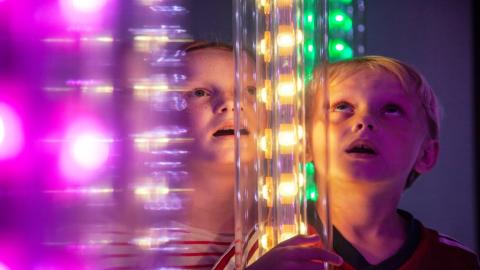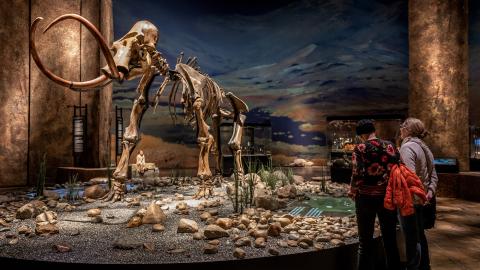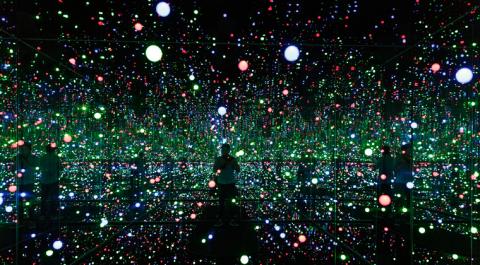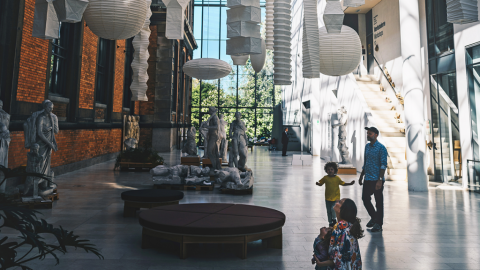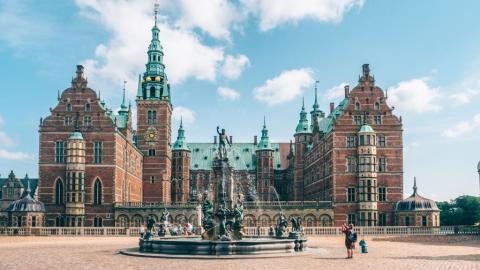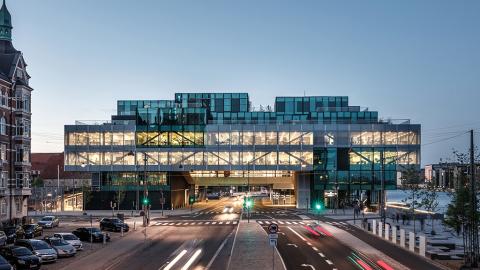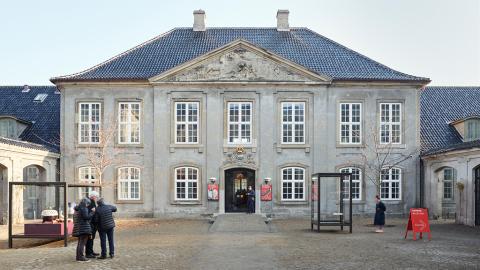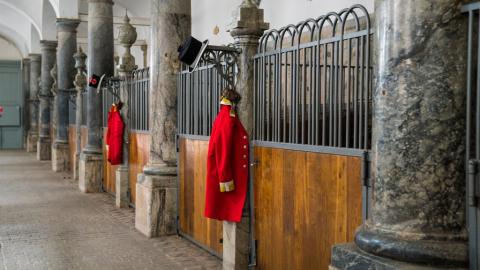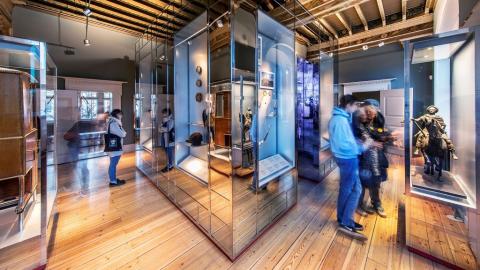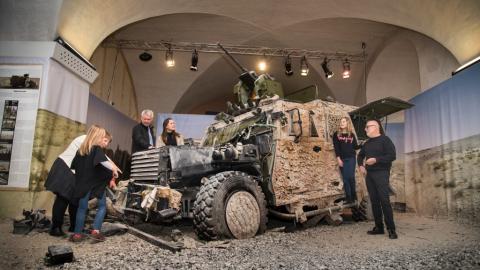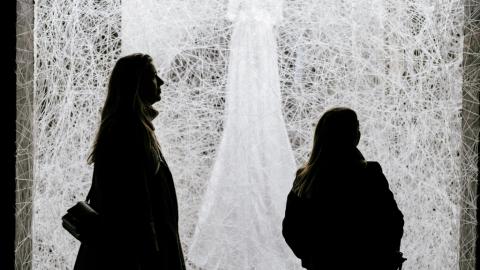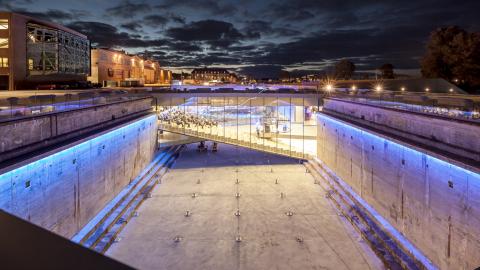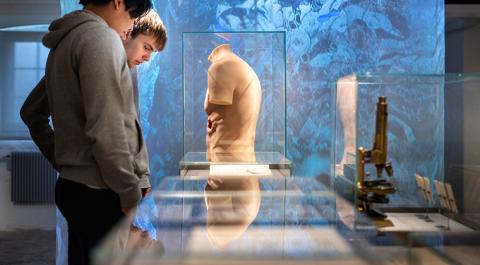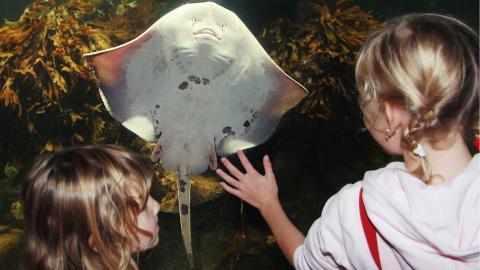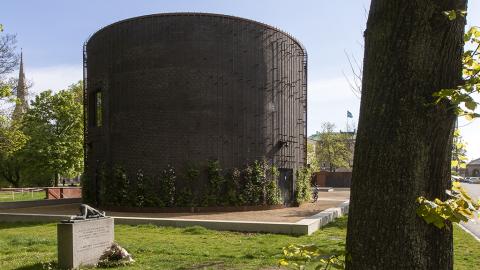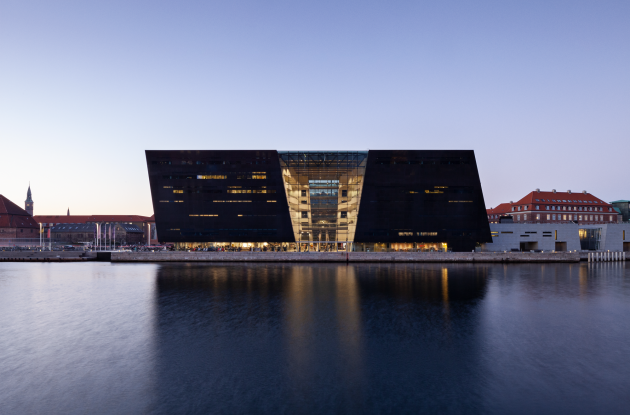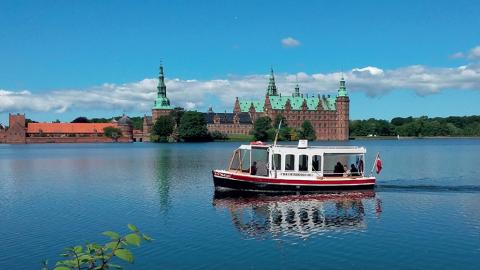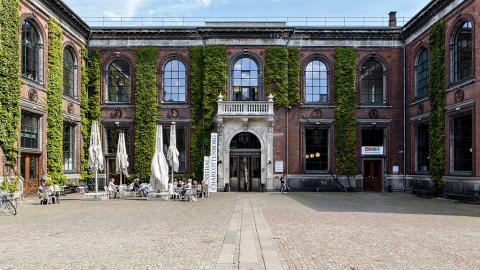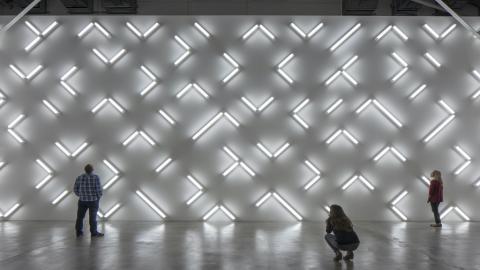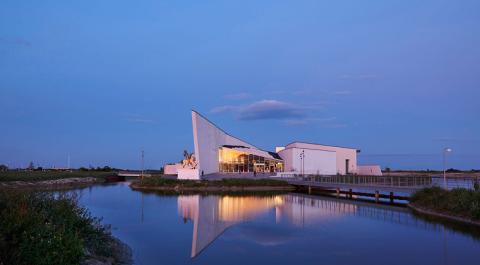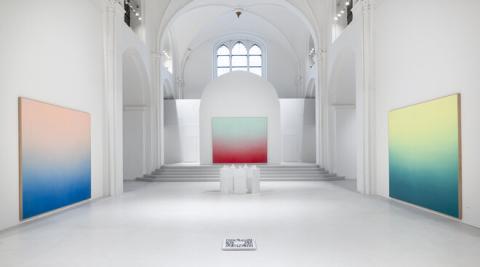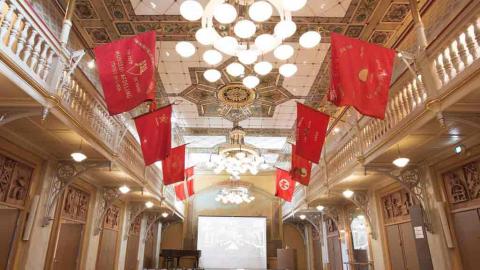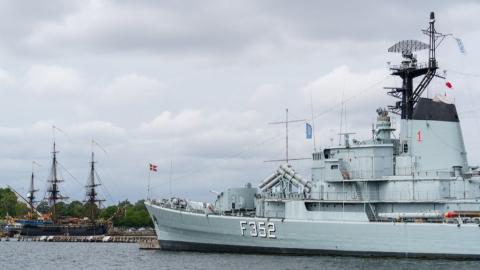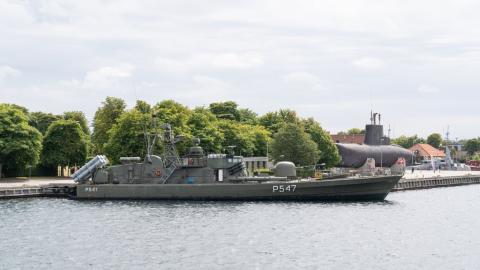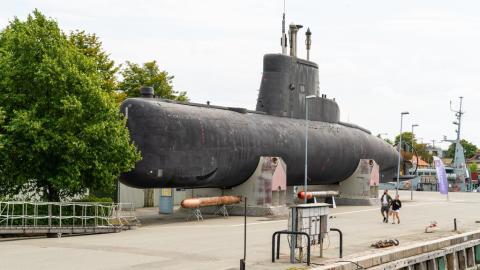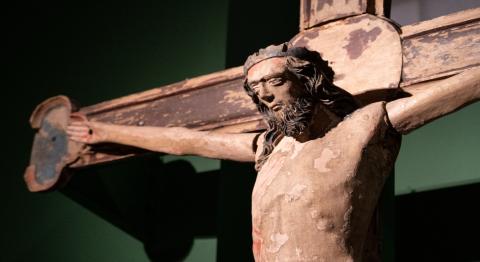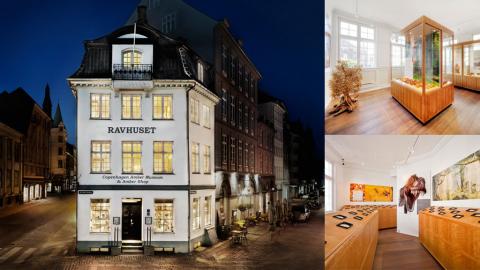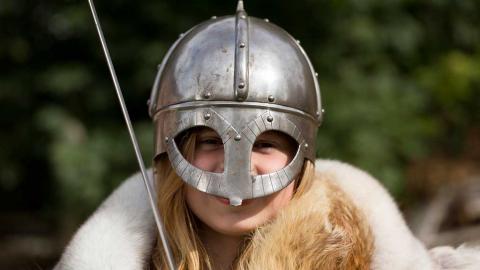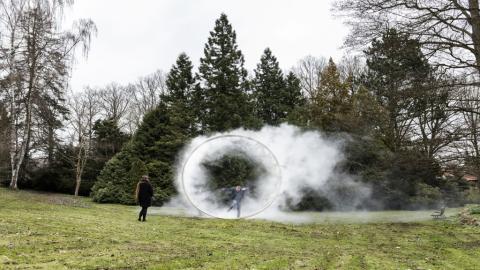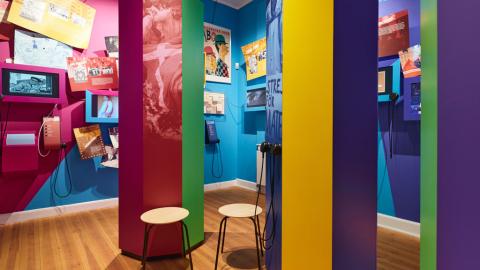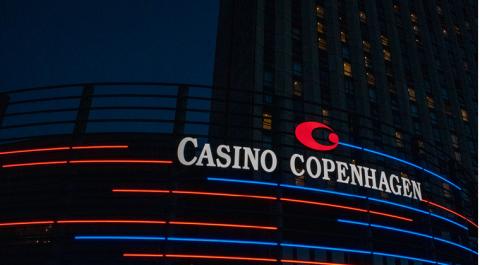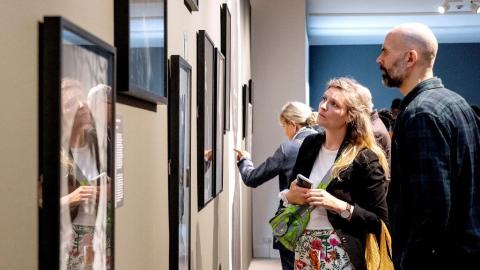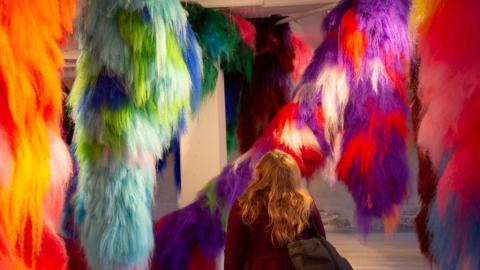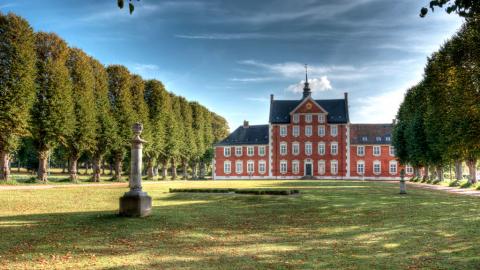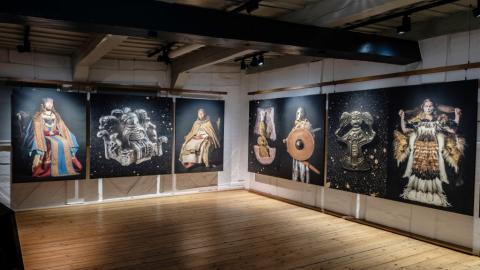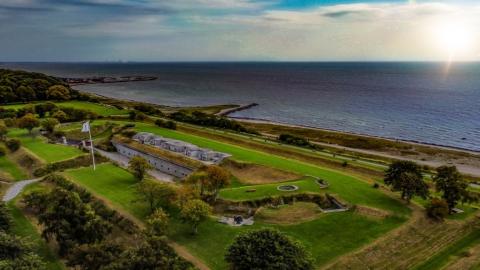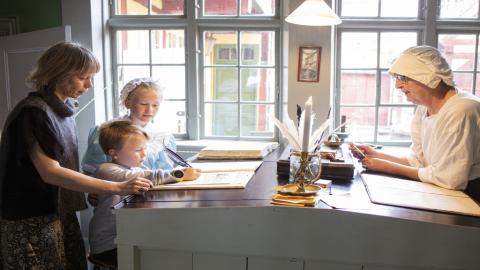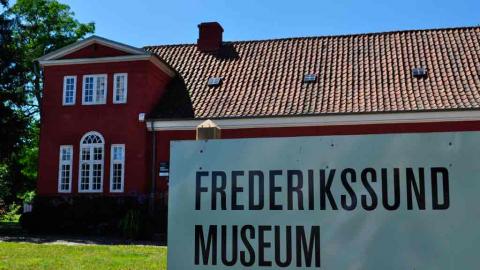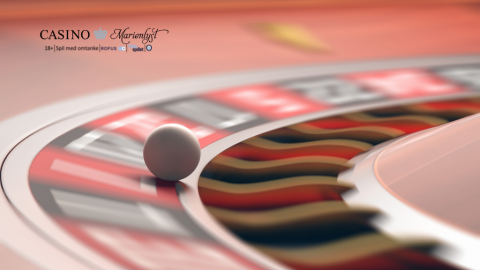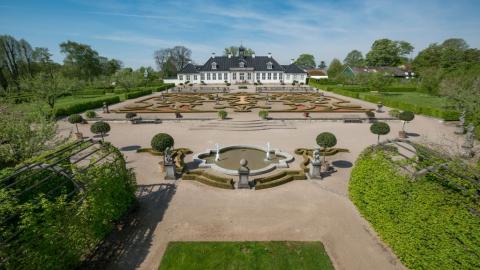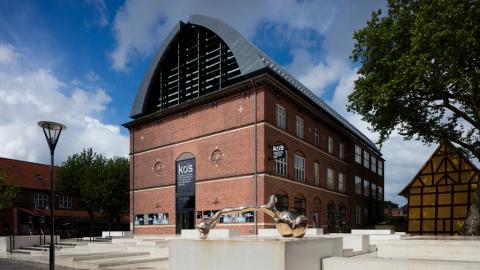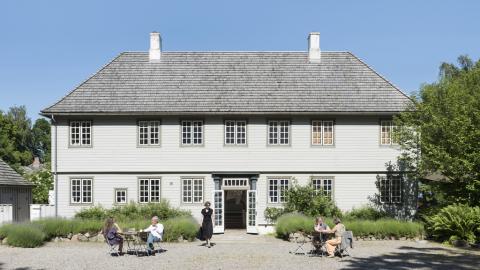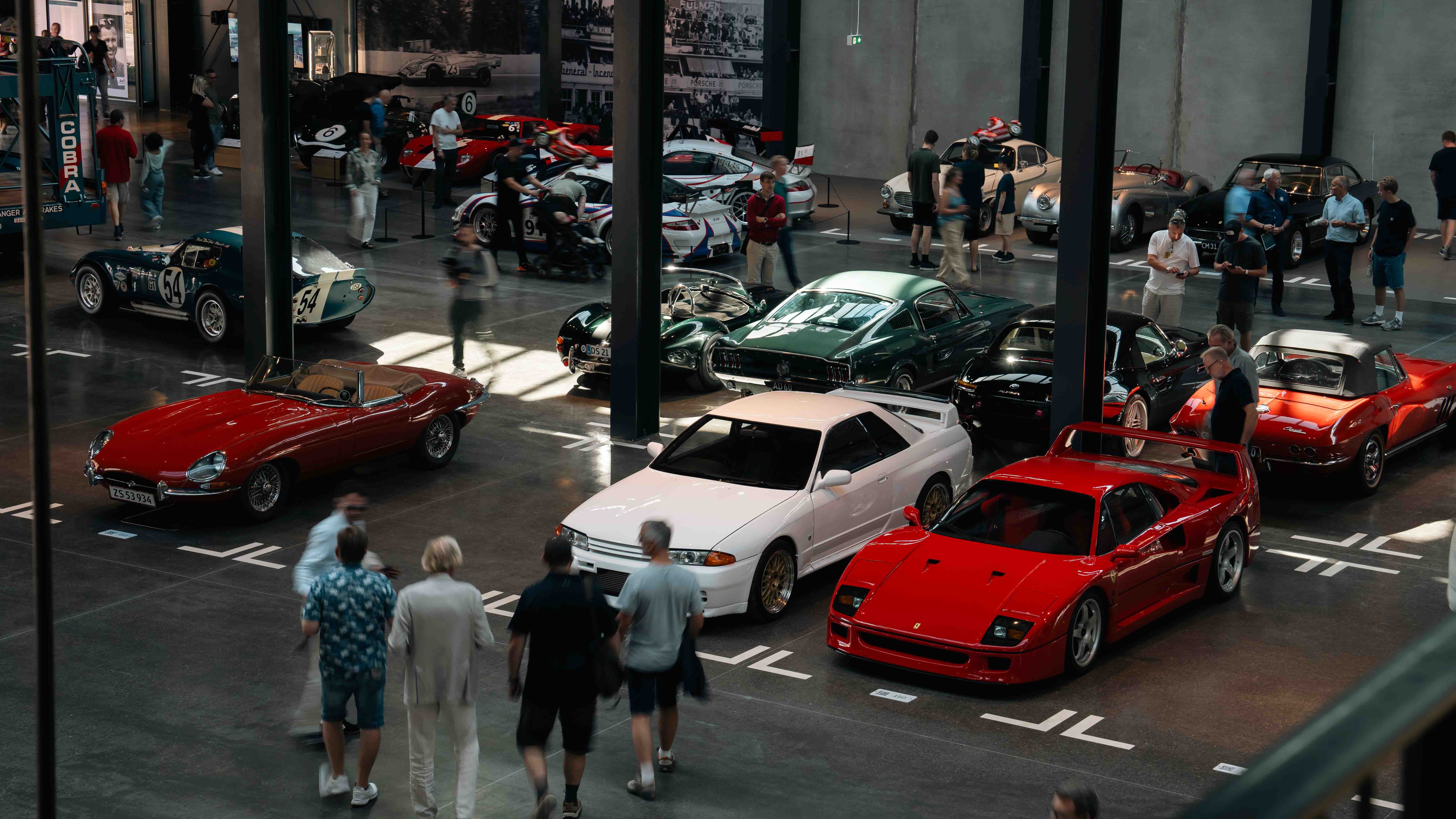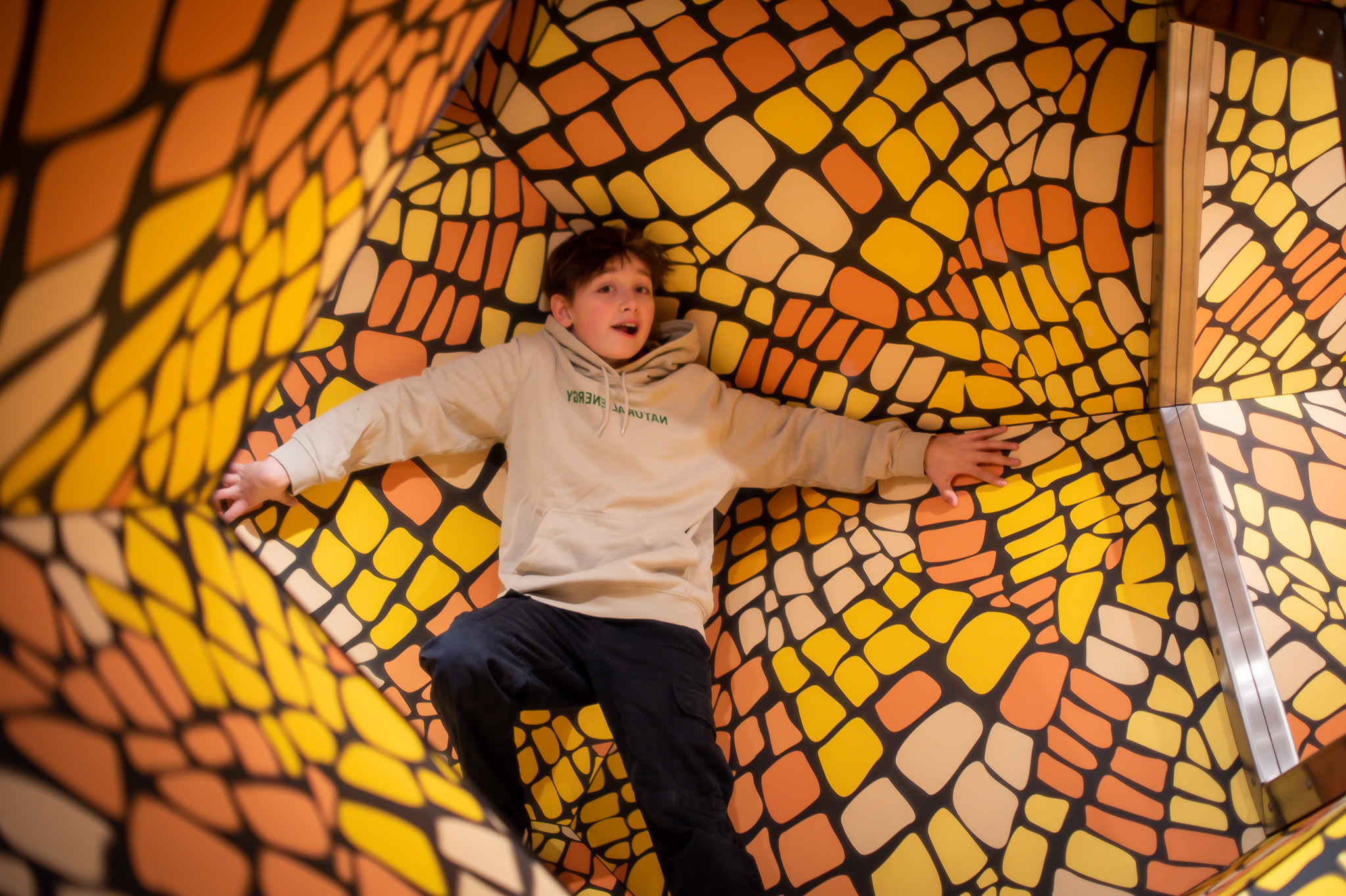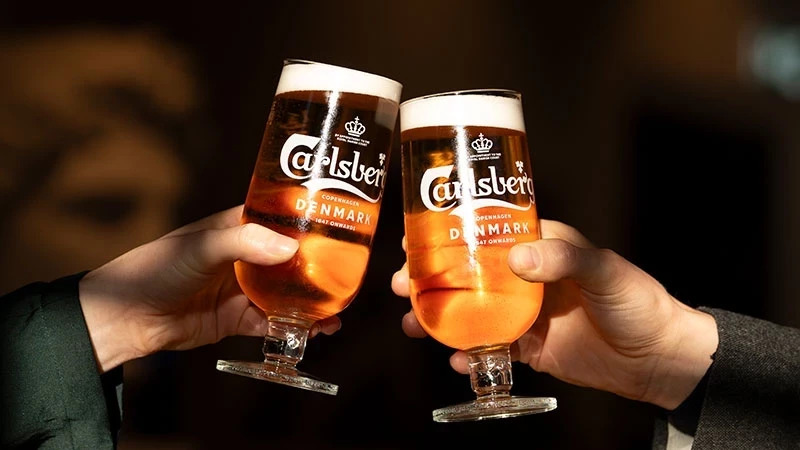Attractions
Please note that opening hours can fluctuate over the year due to seasonality or special events. Approximately half of the included museums and attractions are closed on Mondays and several are also closed on public holidays. We recommend staying updated on the websites of the attractions. Furthermore, please note that a few attractions recommend that you pre-book a time slot.
Copenhagen Card entitles the cardholder to one visit per attraction. Re-visits are not possible.
Finally, please be aware that the attractions included in the Copenhagen Card are revised regularly. This means, e.g., that the National Aquarium (Den Blå Planet) is no longer included in the Copenhagen Card.
List updated Feburary 20th, 2023.
-
Click heart and calculate your savingsA visit to Tivoli is an absolute must for children and youthful souls coming to Copenhagen. The amusement park offers everything from adrenaline rushes to big concerts and unique dining experiences, dazzling lights and beautiful flowers. Part of the secret to Tivoli is that there’s something for everyone. The garden is more beautiful than in any other amusement park and a walk there will reveal exotic architecture, iconic buildings, and lush gardens. At night, thousands of colored lights create a magical atmosphere unique to the place. Tivoli is only a few minutes away from the Town Hall Square and with the Central Station right next door it’s very easy to get to. Re-entry: Copenhagen Card covers ONE visit per card, however, you can re-enter tivoli on the SAME DAY if you get a re-entry stamp from the main entrance.Experience Easter, Summer, Halloween, and Christmas at Tivoli At Tivoli there’s something new to see all year round. The decor in the Garden reflects the changing seasons with colorful Easter eggs, dazzling summer scapes, bewitching Halloween decorations and magical Christmas lights. Summer at Tivoli means countless open-air concerts, inspiring festivals and events, and amusements and fireworks rumbling into the night. Around Halloween, scary ghosts, spiders, scarecrows, and more than 20.000 pumpkins take over the Garden, making it teem with horror, thrills and plenty of autumn fun for the whole family. Summer in Tivoli: 22/3/24-22/9/24 (Påske 22/3-2/4) Halloween: 10/10/24-3/11/24 Christmas: 15/11/24-5/1/25 (lukket 24/12/24) Please note that Tivoli is closed between these periods. Dine in Tivoli At Tivoli you can feast on a world of delicious temptations and culinary experiences. Ranging from pork roast sandwiches to fine dining there’s something for every purse and palate. And once that sweet tooth kicks in, just follow the scent of freshly fried churros, candy floss and coated popcorn. At the Tivoli Food Hall on the corner of the Main Entrance you will find 15 hand-picked stands, each contributing to the wide selection of food experiences. The Tivoli Food Hall is open all year round with free access off the street, so you are always welcome to drop by - even outside the Garden’s opening hours.Feel the presence of history Tivoli was founded in 1843 and has since become a national treasure as well as an international attraction. Author of fairy tales H. C. Andersen visited the Garden plenty of times as did Walt Disney and many other celebrities who have been smitten by the magic of the place. The amusements are all made to fit into Tivoli’s wondrous universe and some of them have become downright iconic, towering above the rooftops of Copenhagen. Tivoli’s oldest and most popular ride is The Roller Coaster constructed in wood back in 1914, only one of the seven roller coasters in the world still featuring a man in one of the carts controlling the brakes manually. On top of that Tivoli boasts the Tivoli Youth Guard, the Pantomime Theatre, Nimb, the Glass Hall Theatre, the Japanese Pagoda, the Tivoli Concert Hall - and plenty of other things to revel in. Entrance and ride tickets Your Copenhagen Card will only cover the entrance. If you wish to go on a ride you will need to get individual Ride Tickets or an Unlimited Ride Ticket.
-
Click heart and calculate your savingsVisit Rosenborg Castle in the heart of Copenhagen and explore some of the kingdom's greatest treasures. The castle features 400 years of splendor, royal art treasures and the nation’s well-guarded Crown Jewels and Royal Regalia. PLEASE NOTE: Your COPENHAGEN CARD needs to be scanned at the ticket office upon arrival at the castle, where your card will be exchanged for a valid, timed entrance ticket. Therefore we suggest you arrive in plenty of time, and expect waiting time in busy periods. OPENINGS HOURS: Plan your visit | Rosenborg (kongernessamling.dk) Rosenborg Castle was built by one of the most famous Scandinavian kings, Christian IV, in the early 17th century. Christian IV fathered more than 20 children, was a patron of the arts and built some of the most significant buildings in Copenhagen. Of his many castles, Rosenborg became his favorite. Today, the glory of the past can be experienced through the impressive possessions of Christian IV and his descendants. Among the main attractions is the Great Hall with the coronation thrones and three life-size silver lions standing guard. The king’s coronation throne is made of nar-whale tusk with gilt figures, while the queen’s is of silver. Tapestries on the walls commemorate battles between Denmark and Sweden. The interiors are well-preserved and invite the visitor to take a journey in time. The visitor can experience the king’s private writing cabinet, his bathroom, and see wax figures of former royal inhabitants. Rosenborg houses one of the world’s finest Venetian glass collections, both set in tower chambers. The crowns of the Danish kings and queens are kept in special vaults with access from Rosenborg’s basement. The crowns are embellished with table-cut stones, enamel and gold ornamentation. They were last used for coronations in 1840. The crown jewels are living treasures, as they are the only ones in the world which are both displayed to the public and in royal use, by HM Queen Margrethe. They primarily consist of four garnitures: a diamond set, a ruby set, a pearl set, and an emerald set – the emeralds being among the world’s finest. Travel back in history Visit The Winter Room; the best preserved room from the original Castle, which was the most important of the Christian IV's three private chambers. The bays are from 1758. In front of the bay to the right stood Christian IV's mechanical arrangement for raising and lowering the drawbridge. Christian IV lay in state here and the exhibits are mostly from his time.
-
Click heart and calculate your savingsJoin a live guided tour around the harbor and through the idyllic canals where your guide will tell you about Copenhagen's beautiful churches, castles, old listed houses, new buildings, and other sights of interest. NB! Copenhagen Card holders must depart from Ved Stranden. If you board the boat in Nyhavn you'll have to pay an additional fee. The classic and original tour, dating back to 1904. With a Copenhagen Card you can board the "Classic Tour" that takes about an hour. You depart from Ved Stranden and pass by some of Copenhagen’s best sights and attractions. The tour is conducted with a live guide in Danish, English and sometimes also a third language (German, Italian, French or Spanish). You can find further information about languages at the ticket office at Ved Stranden. During the tour you will pass by some of the most interesting sights in Copenhagen: The Operahouse, Amalienborg Palace, The Old Stock Exchange, Christianshavn, Our Saviours Church, Battery Sixtus, The Black Diamond, ‘BLOX’, the Little Mermaid and much, much more. During the winter, the boats are covered and heated. Canal Tours sails all year - see time table on website. You can pre-book same-day tickets from the box office at Ved Stranden.
-
Click heart and calculate your savingsOnce home to kings and queens, Christiansborg Palace now houses the Danish Parliament, the Supreme Court, and the Ministry of State. You can visit the state rooms and walk in the footsteps of royalty. The Royal Reception Rooms at Christiansborg Palace in Copenhagen are used by the Queen for official occasions. Walk though gilded rooms and decorated salons, some of which are still used by the Royal Family for various functions and events. The Royal Reception Rooms include The Tower Room and The Oval Throne Room where foreign ambassadors to Denmark are received by the King. The lavish Throne Room gives access to the balcony where the Danish monarchs are proclaimed, with twin thrones to admire. The Great Hall is the most imposing room in the palace. This is where you will find the Queen's tapestries.The Danish business community marked the occasion of Queen Margrethe's 50th birthday in 1990 by ordering a gift of 11 tapestries. Bjørn Nørgaard painted the full-size sketches upon which the tapestries were woven. The tapestry series depicts 1000 years of Danish history.The Prime Minister of Denmark also uses The Royal Reception Rooms in connection with state visits by foreign state leaders. The Alexandra Hall is used for official dinners.If you hold a ticket to the Royal Reception Rooms, you are entitled to a free guided tour of the premises. Other experiences at Christiansborg Palace include a spooky tour of the ruins discovered underneath the palace, which include a wall dating to the Middle Ages, and a trip round the castle's former kitchens, complete with sounds and models. The Reception Rooms are richly adorned with furniture and works of art rescued from the two previous palaces, as well as decorations by some of the best Danish artists, such as Nikolaj Abraham Abildgaard, Christoffer Wilhelm Eckersberg and Bjørn Nørgaard. Admission during opening hours, provided that the royal family is not using the premises for official occasions.
-
Click heart and calculate your savingsWhen the present Christiansborg Palace in Copenhagen was constructed, the National Museum took care to excavate and protect the ruins of the Palace's oldest predecessors, Bishop Absalon's Castle of 1167 and Copenhagen Castle that replaced it. Christiansborg is outstanding in the respect that here you will find, under the same roof, Denmark's political centre of today and the remains of the country's principal castle of the Middle Ages. Revealed by accident When casting the foundations of the present Christiansborg Palace, workers struck upon the ruins of older buildings and the remnants of a curtain wall. Experts were called in from the National Museum, and a close inspection revealed that the ruins dated back as far as 1167. What they had come upon was Bishop Absalon's Castle, once situated on a tiny island off the Merchants' Habour. Walking around this underground site, you will get an idea of how the castle was continually renewed and developed. The later castle and the infamous Blue Tower The Copenhagen Castle, built on the same site, was surrounded by a moat and had a large tower as an entrance gate. The castle was rebuilt several times. King Christian IV added a spire to the tower, the infamous Blue Tower, where only prominent prisoners of state were kept. In the 1720s, King Frederik IV entirely rebuilt the castle, but as a result of this total reconstruction, the walls had become so heavy they started to give way and to crack. King Christian VI, Frederik IV's successor, soon realised the necessity of demolishing the old castle and erecting a new one on the site. This new castle was to be the first Christiansborg Palace.
-
Click heart and calculate your savingsComplete your visit to Amalienborg Palace square – step inside Amalienborg and experience royal life past and present. The Amalienborg Museum presents the private interiors of the most recent kings and queens and a treasury with world class jewellery. Opening Hours: Plan your visit - The Amalienborg Museum (kongernessamling.dk) The scope of the museum stretches back 150 years to Christian IX and Queen Louise, who were known as "the in-laws of Europe" because four of their children ascended to the thrones of England, Greece, Russia and Denmark respectively. As in a journey through time the rooms of the royal couple and their descendants stand intact. Each reflects the modern taste of its period and the personalities of the kings and queens, whether it is in military, Victorian, or knightly style. From February 2020, one of the world’s most important collections of Russian jewellery can be enjoyed in the so-called Fabergé chamber. The collection came to Denmark mainly via empress Dagmar (Maria Fedodorovna), daughter of Christian IX and queen Louise. On most days, there is admittance to the Gala Hall and the other magnificent rooms on the piano nobile. The royal reception rooms are still used by the royal family. Check opening hours on the piano nobile on amalienborg.dk.
-
Click heart and calculate your savingsNy Carlsberg Glyptotek is located in the center of Copenhagen and the museum collection consists primarily of works of art and archaeological objects from Ancient Egypt, the worlds of Ancient Greece and Rome, Etruscan Culture, as well as Danish and French art of the 19th century. Art and beer Ny Carlsberg Glyptotek was founded by the brewer, Carl Jacobsen (the founder of Carlsberg breweries), who was one of the great industrial magnates of the 19th century and the greatest art patron Denmark has seen. In 1888 Carl Jacobsen gave his art collection to the public and began the building of Glyptoteket to house it. Glyptoteket has been open to the public since 1897 and holds over 10,000 works primarily divided between ancient antiquities and Danish and French sculpture and painting from the 19th century. The collection The collection of ancient sculpture includes an extensive collection of Ancient Greek and Roman portrait heads as well as a large collection of Palmyrene portraits. The modern part of the collection includes French sculpture from the 19th century – featuring a significant selection of works by Auguste Rodin – and French painting from 1800 to 1950, with Impressionism and Paul Gauguin as the absolute stars, plus a collection of Danish Golden Age Art. The greater proportion of the collection forms part of the museum’s permanent exhibitions, though there are, also, temporary special exhibitions which help to develop a perspective on the museum’s collection with the aid of works on loan. The Winter Garden, café and roof terraceUnwind from the daily grind at the café overlooking the beautiful and spacious Winter Garden. Picnic is open on the same days as the museum itself. We serve tasty light lunches, desserts, coffee and other beverages. Visit the roof terrace of the Glyptotek and experience a beautiful view of Copenhagen and the city towers. Every summer, the museum café serves cold drinks, snacks, coffee and cake for you to enjoy in open air. Special Exhibithions: Joaquín Sorolla – Light in Motion, 8.11.23-3.3.24 Joaquín Sorolla – Light in Motion is the first-ever solo exhibition in the Nordic region devoted to the work of the Spanish artist Joaquín Sorolla (1863-1923). Featuring one of Spain’s most important painters from the period between the end of the 19th century and the early 20th century, it marks both the 100th anniversary of the artist’s death and the state visit of the Spanish royal family to Denmark in November 2023. (Glyptoteket.dk) After nature, 12.10.2023 - 18.08.2024 In After Nature – A New Reading of the Glyptotek’s Paintings by Writer Josefine Klougart, Josefine Klougart uses the prism of art to study the relationship of humans with nature in a kind of 3-D essay, in which the author’s texts interacts with the Glyptotek’s landscape paintings. Nature as we knew it no longer exists. Klougart explores its beauty, and its disappearance from our modern reality. The sensuous design of the exhibition is the work of the set designer duo Vang Stensgaard. (Glyptoteket.dk)
-
Click heart and calculate your savingsGuinness World Records Museum Visit the only Guinness World Records Museum in Europe. The 1.500 m2 attraction is filled with exciting records in sport, art, music, nature and science. Meet the world’s tallest man who measured 272 cm – and the world’s smallest woman. Experience everything from athletics to motor sports in the Sports Gallery. See the sight of 1.382.101 dominoes topping over, try the world’s largest Pac-Man game and go crazy in our interactive Game Zone. When you scan your Copenhagen Card at the entrance, you also get access to The Mystic Exploratorium located in the same building as Guinness World Records. The Mystic Exploratorium A world of strange phenomena awaits you in The Mystic Exploratorium. Leave your shadow on a wall and swap face with a friend. See the paintings come alive in the dark, and experience what happens at the abandoned graveyard. Do you dare to sit in an electric chair? Explore the dark corridors of the Mystic Exploratorium where you never know what awaits around the next corner… When you scan your Copenhagen Card at the entrance you also get access to Guinness World Records located in the same building as The Mystic Exploratorium.Openings hours:Monday - Thursday: 10 am - 6 pm*Friday - Sunday: 10 am - 7 pm* *Last entry. Museum closes one hour later.
-
Click heart and calculate your savingsOur Saviour's is one of Denmark's most famous churches. Ever since the serpentine spire was inaugurated in 1752, is has been a popular passtime to climb the 400 steps to the top. Please note: The entrance to the church is free of charge for all. If you wish to climb the tower you must book your visit in advance. Please choose the free 'Copenhagen Card' option here. Every year, more than 200.000 people climb the stairway to the top where Our Saviour stands on his globe and overlooks the royal city of Copenhagen. Our Savior's Church's iconic tower contains six large bells and a fantastic carillon which holds special meaning to Christianshavn. With as many as 48 bells, the carillon plays its delicate melodies over the neighbourhood daily. On the last 150 external steps, you will, as far as the eye can see, experience one of the best views over Copenhagen with an overview of the city from every angle at 86 meters. This is not an ascent for the vertiginously challenged! The large baroque church, consecrated in 1696, holds a magnificent organ from 1698 and a beautiful altar. Furthermore, the church has 40 elephants symbolising the absolute monarchy and the Order of the Elephant, the highest order in Denmark. Can you find all the elephants in the church? Access to the tower is limited during crowded hours because of narrow stairs and pathways. Therefore, we recommend prior booking to avoid waiting time for purchasing tickets on-site and to reserve a spot in the tower at a preferred time. The staff can require online booking upon arrival during busy hours if the tower has reached its maximum visitor capacity. Opening hours of the church are daily from 11.00 – 15.30. Please note that the church is closed for sightseeing during services. In the case of rain, snow or heavy wind, the tower closes temporarily for safety reasons. The tower closes on December 31. Closed on 24 and 25 December. Please note that the tower closes at 15 pm. on December 31.
-
Click heart and calculate your savingsExperience runestones, stand face to face with bog bodies, see The Golden Horns, be inspired by the suit worn by the first Dane in space and see an original hash stall from Freetown Christiania. The National Museum tells the history of Denmark from the earliest settlements to the life today. Iconic treasures of Danish history Experience world-famous highlights with a starring role in Danish history. Runestones, The Golden Horns, the suit worn by the first Dane in space and the hash stall from Freetown Christiania that has become a symbol of Danish liberal-mindedness. The Children’s Museum Here you are invited to play and touch everything in sight! Join a raid in the Viking ship, discover a backyard of the 1930s or enter a classroom of the past and experience what school was like for the great-grandparents of Danes. Board the cargo ship and settle down in the berth in the cabin, or explore a Pakistani market and buy food in the bazaar. You can also cook in a Medieval kitchen, or prepare the knights’ castle for defense against enemy attacks. Eat Nordic With clear references to classic lunch and local dishes, restaurant Smör serves new interpretations of Danish food.
-
Click heart and calculate your savingsThe beautiful Botanical Garden is a green oasis in the heart of Copenhagen and home to Denmark’s largest collection of plants from all over the world, incl. species that are extinct in the wild. Here you can go explore among rare cacti and cycads from the age of the dinosaurs. In the iconic Palm House, you get to experience the rainforest from above, and in the summertime, you will find colourful butterflies fluttering among spectacular orchids and vanilla plants in the Butterfly House. The beautiful, Victorian building was built in 1874 and designed by the architect Peter Christian Bønecke and is made from cast iron and glass. The inspiration came from Crystal Palace in London, built for the 1852 World Exhibition. The garden has a charming shop and a coffee cart that offers refreshments on sun-blessed days. The Botanical Garden is part of the Natural History Museum of Denmark, which is situated in the corner of the garden.
-
Click heart and calculate your savingsRipleys's Believe It or Not! Ever seen a letter written on a grain of rice? Ever met anyone who can whistle with a mouth full of tennis and billiard balls? At Scandinavia's only Ripley’s Believe It or Not! you’ll find yourself a long way from everyday life’s normalities and instead delve into a world of curios from around the world. Stare in disbelief as you encounter the two-headed cow that's stuffed but nonetheless real and when you see the amazing but genuine shrunken head no bigger than a clenched fist. Other must-sees include the woman who elongated her neck 34 cm (13,39 inches) using metal rings, the condemned prisoner who survived 13 shots and was granted a reprieve, and the awesome reconstruction of the Taj Mahal, built from 300.000 matches! Wonders never cease... When you scan your Copenhagen Card at Ripley’s Believe It or Not! you also get access to the H.C. Andersen Fairy-Tale House which you will find at the same entrance. Hans Christian Andersen Experience Step into Hans Christian Andersen’s enchanting fairytale world. Learn about his upbringing in Odense and his many journeys. Experience his most beloved stories, from The Little Mermaid to Thumbelina 'come alive' with light, sound and scents. A fantastic experience for everyone. When you scan your Copenhagen Card at the entrance you also get access to Ripley’s Believe It or Not! located in the same building. Monday - Thursday: 10 am - 6 pm*Friday - Sunday: 10 am - 7 pm**Last entry. Museum closes one hour later.
-
Click heart and calculate your savingsPay a visit to the Royal Kitchen under Christiansborg. This is where you can have a unique look behind the scenes of the royal parties and celebrations. What goes on in the royal kitchen when there is a gala dinner at the palace in 1937? The sweet aroma of beef tenderloin for 275 guests wafts out of the ovens - muscular chefs stagger around under the weight of the ton-heavy copper pots - the confectioner constructs exquisite crowns of candied fruit. Come and experience the royal party preparations as they are today and in days of old.
-
Click heart and calculate your savingsKronborg Castle in Elsinore, north of Copenhagen, is one of northern Europe's finest Renaissance castles. It is located at the entrance to Øresund and was built in 1574-1585. Kronborg Castle is probably the most famous Danish castle, known worldwide from Shakespeare's Hamlet. Hamlet's spirit is still roaming the hallways of Kronborg, and every summer you can experience Hamlet Scene perform Hamlet on an open-air stage in the courtyard. Frederik 2's Kronborg is at once an elegant castle and a monumental military fortress surrounded by considerable fortifications with bastions and ravelins. It has not been inhabited by the royal family since the late 1600's. The castle houses collections of Renaissance and Baroque interiors, and among the main attractions is the 62-meter ballroom, the very well-preserved chapel and the mythological statue of Holger Danske below the castle. Queen Caroline Mathilde under house arrest In 1772 Kronborg Castle played a minor role in the fatal drama between the insane King Christian 7, his wife Queen Caroline Mathilde and her secret lover Johan Friedrich Struensee. After the arrest of Struensee in Copenhagen 17 January 1772, Caroline Mathilde was taken to Kronborg Castle, where she was under house arrest for a period of time. Her fate was long uncertain. She was accused of infidelity, and although her defender Peter Uldall did what he could, she was convicted, divorced from the king and banished to the town of Celle in northern Germany. She never saw her children again and died a few years later of an epidemic. A trip to Kronborg is the perfect start to a day in Elsinore. With Copenhagen Card you can also visit the Maritime Museum, the Øresound Aquarium and much much. From 1785-1923 Kronborg Castle was inhabited by the Danish military. The castle was added to UNESCO's World Heritage List in 2000. Closed Dec 24, 25 and 31
-
Click heart and calculate your savingsIn Copenhagen ZOO, you can meet more than 4,000 fascinating animals and travel between continents in just one day. Get familiar with the iconic giant pandas while dining in the state of the art Panda House. Experience unforgettable close encounters with polar bears and see the world from a giraffe’s perspective at the savannah. Discover lots of animal facts and enjoy a meal from the grand selection of food stalls. Please visit the Zoo's website to learn about feeding-times, new animals-babies and the daily programme. Architecture at Copenhagen Zoo The animals aren't the only thing to marvel at in the zoo. The zoo is also home to some architectural delights, not least the panda habitat designed by Bjarke Ingels Group, and the elephant house, designed by Norman Foster. Architecture fans might also enjoy looking at the Hippopotamus House, which opened in 2007 with walls patterned like a hippo's skin, and the Arctic Ring, which allows you to see the polar bears swimming under water. Restaurants in Copenhagen Zoo At Bistro Panpan, you can enjoy French dishes with an Asian twist at the Panda House. At Cakes & Dreams, you can enjoy delicious pastries. Spisehuset FOLK is a cozy and traditional restaurant serving classic, Danish food such as open sandwiches. All around the Zoo, there are snack stalls and stands where you can buy hot and cold drinks and ice creams. A world to explore awaits. ZOO is filled with explorations every day 365 days a year. Please be aware that opening hours may change rapidly - we recommend checking the ZOO's website before going
-
Click heart and calculate your savingsLet’s Play Science! Experimentarium is a world class science centre in Hellerup, just 6 km north of Central Copenhagen. Explore Science the Danish Way! At Experimentarium science is hands-on, intuitive and fun for all ages and nationalities – you simply jump right in and get started! TIME Magazine has named Experimentarium one of the World’s 100 Greatest Places in 2018. The science center re-opened in 2017 after a complete makeover more than doubling it in size. Experimentarium brings science to life through hands-on exploration. Three indoor floors filled to the brim with interactive exhibitions, a science themed museum shop, a science-themed eatery and an interactive rooftop with a spectacular view. Future Human - How far will you go? Right now, artificial intelligence is rapidly turning the world upside down. But there are more technologies on the horizon with the power to change your life. Are you feeling depressed? Fix it with a brain implant! Have you lost your beloved pet? Why not clone it? Don’t trust your new partner? Test them with emotion-sensing technology! Soon you’ll be able to do it! But would you want to? Future Human – How Far Will You Go? zooms in on six technologies that are expected to have a significant impact on our lives in the next 10-15 years. Hands-on science highlights Experience a lifetime in the Tunnel of Senses, be tricked by light and darkness in the Labyrinth of Light and jump to be part of the movie in the Interactive Film Theatre – the world’s first interactive cinema based on movement sensors. Dive into the physics and chemistry of water and go on an underwater safari in the mysterious submarine in Experimentarium’s water exhibition The Beach. Get the ball rolling in the world’s largest interactive ball track and learn an important lesson about world trade and CO2. Do not miss The Bubblearium, where you can blow the most amazing soap bubbles and learn fascinating bubble-science. The Miniverse – science for toddlers Children are natural born scientists - every day they discover new things and learn about the world through play. The Miniverse is a fun, inspiring and safe environment that nurtures children's basic understanding of science. For children aged 1 to 5 years and their adults. How do you get here? S-Train to Hellerup Station or Svanemøllen Station or Metro M3 to Poul Henningsens Plads Station. From either station take bus 1A to Tuborg Boulevard (Standvejen).
-
Click heart and calculate your savingsStep into the beautiful mineral halls, touch a huge meteorite from outer space and explore the natural world in the changing exhibitions. An annual highlight at the museum is the famous exhibition Wildlife Photographer of the Year, featuring the 100 best nature and wildlife photos worldwide. Experience the beauty and fragility of nature in an exhibition that delights millions of people every year. See more about the exhibition at wpy.dk. Recharge in the café with a view of the Botanical Garden, where you can explore the museum's collection of rare plants and see the iconic Palm House.
-
Click heart and calculate your savingsThe Louisiana Museum of Modern Art is a leading international art museum and an absolute top attraction in Denmark. Art, nature, and architecture combine in a total experience that attracts guests from all over the world all year-round. The Museum is located approx. 40 km north of the city center in Humlebæk, in a beautiful old park offering magnificent panoramic views of the Sound. The park provides a magnificent setting for Louisiana’s large sculpture collection. The museum collection of modern art is one of the most important in Scandinavia and on view in changing presentations. Permanent highlights include the Giacometti Hall and the Jorn Room and there is also regularly access to one of Kusama’s Infinity rooms. Classics and shooting international stars The Louisiana Museum is internationally recognized for its exhibition program, with 8 - 10 major exhibitions annually. Here, the classics of modern art, as well as contemporary international artists and architects, are presented. A vibrant cultural center for children and adults alike With its relaxed atmosphere, the museum also offers a vibrant and dedicated cultural centre with a rich programme of activities and events for children and adults alike. Take a break at the Louisiana Café When it’s time for a break, the Louisiana Cafe welcomes you to enjoy hot drinks, cakes and a delicious, seasonal lunch and dinner menu. From here you have an astounding panorama view of the sea.Shop Scandinavian design in the Louisiana Store In the museum’s sizeable two-level store, you will find a large and inspiring selection of new and classic items with an emphasis on Danish and Scandinavian design. Interior, clothing, books, posters, graphics, toys and more. Special exhibitions (Louisiana.dk): Det uerstattelige menneske, 23.11.23-1.4.24 With works by more than 60 artists, this large-scale, interdisciplinary exhibition seeks to define the phenomenon of creativity from a broad, humanistic perspective. What are the conditions for creativity in society today? And is there reason to fear that artificial intelligence will take over and surpass human creative abilities? The exhibition The Irreplaceable Human – Conditions of Creativity in the Age of AI aims to create the foundation for a conversation about the role of creativity in our society – and thus also for a discussion about what is really valuable to us. The exhibition presents works by more than 60 artists – with the main emphasis on art from the past 20 years – combined with references to cultural history, science, and literature. Bourgeois X Giacometti, 9.1.24-26.5.24 In the North Wing, Alberto Giacometti, whose works constitute a significant pillar of Louisiana's collection, has been joined for the first time by Louise Bourgeois – another of the 20th century's all-time great artists – and her iconic sculpture 'Spider Couple'. Entirely exceptionally, the sculpture ‘Walking Man’ by Alberto Giacometti is on loan this spring, and in its usual place you will instead find the monumental ‘Spider Couple’ from 2003 by French-American Louise Bourgeois (1911-2010): a rather special meeting between two artists who are beacons of 20th-century art history, as well as of the Louisiana Collection. Giacometti and Bourgeois knew each other, and their art expresses a lifelong preoccupation with the human body and psyche, albeit in very different ways. Nan Goldin - Memory Lost, 12.1.24-22.3.24 American photographer and activist Nan Goldin has just been named the world's most influential artist by Art Review Magazine. Currently you have the chance to revisit her latest masterpiece 'Memory Lost' in our West Wing Cinema.
-
Click heart and calculate your savingsSMK – The National Gallery of Denmark SMK - The National Gallery of Denmark (Statens Museum for Kunst) is Denmark’s largest art museum, featuring outstanding collections of Danish and international art from the past seven centuries. SMK is located just off of Copenhagen's Nørreport station. Here you can experience special exhibitions, the royal collections, guided tours, performances, art talks, concerts, workshops and much more. At the SMK you can enjoy the grand masters of art history along with cutting-edge contemporary artists and the rising stars of the art scene. No other museum in Denmark shows such a rich and varied selection of art – from the European classics of the Renaissance to the overwhelming diversity of modern and contemporary art. Here you will find gems by artists such as Mantegna, Nolde, Anna Ancher, Derain, Rubens, Matisse, Hammershøi, Munch, Abramovic, Danh Vo and Elmgreen & Dragset. SMK is especially famous for its beautiful collection of Danish Golden Age art, the country’s most comprehensive collection of Danish contemporary art – and one of the world’s best Matisse collections.
-
Click heart and calculate your savingsExperience Frederiksborg Castle and Museum of National History with magnificent halls, portraits, history paintings, and special exhibitions, located just 35 minutes north of Copenhagen. The impressive Renaissance castle was built by Christian IV to showcase the king's power. With its fairytale-like location in the middle of the Castle Lake, surrounded by the Baroque Garden and the romantic landscape garden, Frederiksborg Castle offers a unique destination with great cultural experiences, garden walks, and boat trips with the Little Ferry on the Castle Lake throughout the summer. Museum of National History Museum and National Portrait Gallery Christian IV's (1588-1648) magnificent castle from the early 17th century now serves as the framework for more than 500 years of stories and myths that shaped Denmark into what it is today. Frederiksborg Castle is both Museum of National History and the National Portrait Gallery, where hundreds of portraits give faces to individuals who have shaped Denmark's history. The portrait collection is the country's largest and most significant, and the collection of paintings, busts, drawings, and photographs is continuously supplemented with new works. History paintings also communicate important national events. Experience the pomp and splendor of bygone times up close. The museum's fine period interiors and the castle's impressive grand rooms, such as the Castle Church, the Great Hall, and the Audience Hall, provide insight into changing periods and styles. Additionally, changing special exhibitions on portrait art and the history of both Denmark and Frederiksborg Castle are shown each year. The museum has been housed at Frederiksborg Castle since 1878 when it was established by the founder of Carlsberg, brewer J.C. Jacobsen, after a devastating fire in 1859. The museum continues to operate as a department of the Carlsberg Foundation. Frederiksborg for children Experience Frederiksborg Castle from a child's perspective with one of the museum's treasure hunts or the children's audio guide. During holiday seasons, there are special activities for children. Visit dnm.dk for current activities. Make the most of your visit Download the Smartify app for the museum’s audio guides. Use the app to scan and explore portraits and paintings. Download the app before your visit to be well-prepared. Also, keep an eye out for the museum's podcast PORTRÆT, which delves into both the castle and its collection. Dine at Rabarbergaarden Slottet The museum's restaurant, Rabarbergaarden Slottet (meaning the Rhubarb farm at the castle) brings the flavors of North Zealand to the table. Enjoy a gastronomic experience with local, organic ingredients from the sustainable farm-to-table kitchen. The restaurant is located in a former carriage port and stable building, offering views of both a lake and the castle at Northern Europe's largest Renaissance complex. The Castle Gardens Frederiksborg Castle was completed by creating gardens around the grand building complex. Christian IV had his own garden, but in 1720, architect J. Krieger was commissioned to create a Baroque garden. The Baroque Garden was recreated in the 1990s. The lowest terraces in the garden feature four monograms in tightly trimmed hedges: Frederik IV, Frederik V, Christian VI, and Margrethe II. These are the four monarchs under whom the garden has existed, from its establishment by Frederik IV to its restoration in Queen Margrethe's time. However, the Baroque Garden is not the only garden at the castle. Next to the Baroque Garden is the romantic, English-inspired garden, where a small Bath House Castle is also located. With its small lakes and groves, the romantic garden is designed to convey moods and showcase the beauty of nature. In contrast, the Baroque Garden with its straight lines and sharp edges represents the beauty that lies in human control over nature. Getting There The museum is open every day of the year. It takes approximately 35 minutes to drive from Copenhagen. If you are coming by train, the easiest way to reach Frederiksborg is via the S-train line A. It takes about 15 minutes to walk from Hillerød Station. You can walk along the Castle Lake or through the city's pedestrian streets with cafes and shops. Special Exhibitions: 12/01 2024 - 21/04 2024: Images of a queen Frederiksborg commemorates the succession to the throne with an exhibition featuring portraits of Her Majesty Queen Margrethe. Explore Andy Warhol’s iconic glitter-adorned silk screen print portrait of Her Majesty, official portraits such as Rigmor Mydtskov’s photographic portrait from 1972, as well as a wide range of photographs, paintings, and drawings created between 1940 and 2022. From gala events at Fredensborg to gray weather on the beach, Her Majesty is depicted as introspective, dreamy, and creatively expressive. The young heir and Princess Margrethe. Her Majesty in different stages of life and situations.
-
Click heart and calculate your savingsOut of this world experience for the whole family NB: Opening hours may vary with special events. Please check Planterium's own website for updated opening hours. Immerse yourself in the starry sky and experience films in the unique Planetarium Dome, which has recently undergone a complete transformation. The Planetarium has the largest tilted dome in Europe, an enclosing canvas, a razor-sharp visualization in 8K and second-to-none sound system. Learn more about where we came from and what we’re made of in the Big Bang exhibition in the room Cosmos or explore the installation Rings of Saturn and put your senses into play. Planetarium conveys the knowledge of astronomy in the form of films, exhibitions, lectures and other special events. On weekends and Holidays Planetarium also offer a special activity programme for both adults and children Entrance and movie With your Copenhagen Card, you can visit the exhibitions and watch one movie in The Dome. You can find the current movies here.
-
Click heart and calculate your savingsThe Viking Ships in Roskilde The Viking Ship Museum exhibits the five 1000-year-old original ship finds from the Viking Age (the Skuldelev Ships) as well as a fleet of sailing reconstructions. Several of these reconstructions and other Nordic boats are also available to sail in. You can also meet the craftsmen who keep up the traditions of the old maritime trades, and you can try your hand with axes, ropes and many other activities. The permanent exhibitions are focused on the five Skuldelev Ships. The goal of these exhibits is to tell the story of these ships and of the many Nordic maritime adventures during the Viking Age. The five original Viking ships stand majestically with the Roskilde Fjord as a living backdrop. With this view, it becomes easy to imagine how the merchant set off for distant shores with his goods, the warriors waved goodbye to their families before the voyage and the fisherman embarked on the fjord with the hope of returning with a good catch. Sailing trips on Roskilde Fjord - Climb on board! Board a Viking ship and get up close!The Museum is the only place in the world where you can experience seeing 1000-year-old Viking ships, and then go directly out to the Museum harbor, where the full-scale reconstructed Viking ships lie moored at the quayside. The Viking Ship Museum invites its guests to take part in unique sailing trips with either Viking ships or traditional Nordic boats, which are the descendants of the Vikings' ships. Viking ships were originally used for war, trading, fishing and transport during short every day trips or on longer voyages to foreign shores. We go sailing on Roskilde Fjord every day with pre-booked corporate groups, school children and international group visitors. Take your family or friends with you for a special experience in an historical context, but with modern safety standards. You buy your ticket as an addition to the entrance ticket and during the summer season timeslots are posted and updated daily on our website.
-
Click heart and calculate your savingsStart your exploration of Copenhagen at Danish Architecture Center (DAC). From the spectacular modern home in BLOX on Copenhagen’s waterfront, the international cultural attraction presents exhibitions, guided tours and events on historic icons and new highlights in Danish architecture and design for both children and adults. You can also shop new designs, art and books in the DAC Design Shop or enjoy coffee in the DAC Café with a view of Copenhagen harbor. Architecture exhibitions with leading Danish and international profiles Get inspired by the biggest stars in architecture and design. DAC showcase changing exhibitions on the most creative and talked-about Danish studios, including BIG (Bjarke Ingels Group) and Olafur Eliasson; works from historic masterminds such as Arne Jacobsen; and new trends in housing and daily life. Current exhibitions (dac.dk): So Danish! Explore the new permanent exhibition - So Danish! - that covers the history and development of Danish Architecture all the way from the Vikings up until modern days. See how architecture ahas shaped the development of the Danish society and learn about how architecture can help create a sustainable future. Chaning Our Footprint, 17.11.23 - 26.5.24 How do we succeed in creating a sustainable transition of architecture? Explore materials and methods of the future which can help pave the way for building on the planet’s terms. Guided tours Get the close-up experience of Copenhagen’s architecture with their expert guides. Discover the masterpieces and the city’s hidden gems – from Nyhavn to the 8 House and bicycle bridges to harbor baths. DAC offer tours every week. Tour ticket gives free access to DAC exhibitions within 24 hours of the tour. Kids and families Architecture is for kids too! On weekends and holidays, they invite you and your kids to family workshops. You can build, draw and design with help from our DAC learning team. Try the thrilling DAC Slide, enjoy the outdoor playground and end the day with family-friendly food in the DAC Café. DAC Café In DAC Café, you experience Copenhagen anew – high above Copenhagen’s vibrant city life and harbour. Have a break on one of our rooftop terraces and enjoy tasteful Nordic dishes, refreshments or a good cup of coffee. DAC Design Shop DAC Design Shop is your destination for design and architecture in Copenhagen. Explore a hand-picked selection of new Danish design. DAC offer everything from jewelry, watches and fashion to books, prints and designs for children. All objects in the store are carefully selected with a focus on sustainability and innovation. The range and decor are a holistic experience that constantly changes every time you visit us. The DAC Design Shop is the perfect place to find great gifts for your loved ones or for yourself.
-
Click heart and calculate your savingsWith a unique location in Copenhagen’s historic centre, near tourist attractions, the harbour boats, design companies and galleries, Designmuseum Danmark is a working archive and the entrance to Denmark as a design destination. Experience one of the world’s largest collections of Danish design, counting works by Finn Juhl, Arne Jacobsen, Poul Kjærholm, Verner Panton and Hans Wegner. In addition, the collections cover applied art and design from Art Nouveau to contemporary Danish design and include glass, ceramics, fashion, textile and poster art. The museum, situated right next to Amalienborg, is one of the finest examples of rococo architecture in Copenhagen. It offers thematic design exhibitions, special events, guided tours and workshops. Visitors are also invited to explore our beautiful garden, the café with indoor and outdoor service, the museum shop, and library. Special exhibitions: Rocks of Greenland: 21.7.23-31.3.24 Join us on a journey to the depths of Greenland's underground, where gold and rubies sparkle. The exhibition ROCKS OF GREENLAND – KALAALLIT NUNAAT ROCKS invites the audience on a fascinating journey of the precious materials - from their extraction in the mines to their shimmering display as jewelry or artworks in the exhibition. PROUD, 5.10.23-26.5.24 Join fashion designer Nicholas Nybro on a design adventure across Denmark, from Amager to Ærø and from Hirtshals to Højer, resulting in 21 vibrant, diverse, and modern folk and regional costumes. The Future is Present, 19.6.22-31.12.24 Currently, designers around the world are working on solving some of our global challenges. Thinking radically and creatively, allowing themselves to be guided by both reason and emotion. Akut, series Welcome to an exhibition about what is happening on the design scene right now. AKUT showcases everything from trends and tendencies to design, which address current issues and provide new perspectives on design and crafts.
-
Click heart and calculate your savingsThe Royal Stables are located at Christiansborg Palace on the island of Slotsholmen in central Copenhagen. In 1789 the number of horses reached a peak with 270 horses stabled. Today, there are about 20 horses in the Royal Stables. Shortly after his accession to the throne in 1730, King Christian VI had the old and outdated Copenhagen Castle torn down to make way for a new Baroque palace: the first Christiansborg Palace. The old stable complex behind Copenhagen Castle was also torn down to make way for a new and larger stable complex. The new and still existing stable complex was constructed from 1738 to 1745. The complex included an outdoor riding ground surrounded by buildings containing an indoor riding school as well as stables with room for a total of 87 riding horses and 165 carriage horses. Part of these stable buildings still remain unchanged since their inauguration in 1746 with an extravagant decoration of marble pillars. A lively museum The museum has three departments: The Harness Room with old uniforms of the Royal Stables and the splendidly decorated eight-horse harness with a wealth of lovely details - the actual Stables with the Royal Family's carriage and saddle horses, and finally the Coach Hall with old well-preserved state coaches and carriages.
-
Click heart and calculate your savingsExperience an architectural masterpiece, where 1000 years of Danish history and 40 kings and queens lies buried under beautifully decorated vaults and in dark crypts. The Cathedral is a UNESCO World Heritage site. NOTE: Opening hours can vary. We kindly ask you to check the website. Venture on a time travel from the Middle Ages up until today. The cathedral’s long history and numerous chapels take you through 1000 years of Danish history and 800 years of European architectural history. This magnificent red brick Cathedral is a truly unique structure, and considered to be one of Denmark’s most important buildings. Its history can be traced as far back as the Viking king Harald ‘Bluetooth’. He is believed to have been buried on this site around 987. Construction of the present church began around 1200. The church is the first Gothic church buildings in Scandinavia built in bricks, and with its soaring arches and huge windows, it provides you with a fantastic impression of the Gothic idea of creating churches filled with light. With its many royal chapels, all built in their own distinctive architectural style, a visit to Roskilde Cathedral is a fascinating architectural odyssey. The royal family’s burial church In Roskilde Cathedral, 40 kings and queens lie buried in beautiful sarcophagi and coffins, from the Middle Ages until the present day. Get close to the woman behind the union of Denmark, Sweden and Norway Margrete I or Europe’s parents-in-law King Christian IX and Queen Louise. The sepulchral monument of the current Queen Margrethe II his already in place. As something unique, you can sit on the bench covering the monument until the death of the regent.
-
Click heart and calculate your savingsHOW TO BECOME A COPENHAGENER Copenhagen is one of the world’s most livable cities. But who are the Copenhageners and what kind of city is Copenhagen? Begin your visit in Copenhagen at the Museum of Copenhagen, located in a beautiful, historical building right behind City Hall. You’ll be introduced to all the most important places and events in the history of the Danish capital. From the city of the Viking Age, through the building boom and plague, fires and bombings, to the free city of Christiania today. A vast array of unique, original exhibits bring the city and its people to life. Our interactive model gives you an overview of the entire city – perhaps you will end up as a Copenhagener yourself! THREE HIGHLIGHTS See the 600 years old shipwreck of a keel Examine an early edition of today’s Copenhageners’ favourite means of transport – the bicycle! Get an overview of the city on the Copenhagen Panorama with our large scale, interactive model. In a hurry? Se the highlights of the museum in just 30 minutes. CAFÉ & SHOP Find an original gift in our museum shop, which offers everything from postcards to handcrafted design or relax in the café or in the ‘hyggelige’ courtyard.
-
Click heart and calculate your savingsTake a walk through Danish war history from the 1500s until today, and explore the treasure trove of equipment from samurai swords and medals to ship models and massive howitzers. Experience life as a deployed soldier as you step into Danish military camps from Afghanistan. Stay alert in the watch tower, and climb into an actual PMV hit by a roadside bomb. Also, get an overview of Danish war history. From knights in shining armour, wars with the Swedish and the English, to World War II, the Cold War and the war in Iraq. Or relax in the hammocks as you hear stories from the seven seas. The Danish War Museum is located in king Christian IVs arsenal on Slotsholmen in the heart of Copenhagen. When the arsenal was completed in 1604 it consisted of a war harbour, an arsenal and armoury, a provisions building with a bakery and a brewery, and an array of different workshops. We will take you on an exciting journey through the past 500 years of Denmark’s wars – from famous battles against Sweden and England to Afghanistan.
-
Click heart and calculate your savingsArt gallery, water reservoir and urban dripstone cave The subterranean space beneath the green lawns of Søndermarken Park works as a breathtaking stage for contemporary art installations. The cold, humid and dark old water reservoir might remind you of long-forgotten cathedrals and gloomy catacombs – it is sparsely illuminated, and the atmosphere evokes fascination and enchantment in both children and adults. Every year Cisternerne invite an internationally recognized artist or architect to create an exhibition particularly to this underground space – an exhibition in large scale that interacts with and emphasizes the unique architecture, climate, atmosphere and history of Cisternerne. March 17th to November 30th 2024: Start Again the Lament by Taryn Simon Cisternerne presents an extensive sound installation by artist Taryn Simon. Building everlasting recitations of loss, Start Again the Lament explores how we mourn individually and collectively, considering the anatomy of grief and who we choose to guide us through it. In the act of lament, discontent is publicly performed. Professional mourners are granted the authority and solicited by the bereaved to occupy, negotiate, and shape their loss. In a relentless replay, the lamentations of professional mourners are broadcast into the reverberating space of Cisternerne. These sonic rituals of grief include northern Albanian laments, which seek to excavate ‘uncried words’; Wayuu laments, which safeguard the soul’s passage to the Milky Way; Greek Epirotic laments, which bind the story of a life with its afterlife; and Yazidi laments, which trace a topography of displacement and exile. Cisternerne becomes an instrument echoing recitations of loss with a reverberation of 17 seconds.
-
Click heart and calculate your savingsM/S Maritime Museum in Elsinore is one of the most talked about museums in recent years. It has been named ‘A cutting-edge cultural venue’ by New York Times and ‘One of the eight greatest new museums’ by BBC. A sensory experience awaits with stunning architecture and modern, interactive exhibitions. From a distance it is almost invisible, but below sealevel - in the middle of the newly renovated Culture Harbour and next door to Kronborg Castle - lies the Danish Maritime Museum, M/S Maritime Museum of Denmark. If you follow the sloping bridges into the old dry dock, you will experience one of the most spectacular new buildings in Denmark of the recent years.M/S Maritime Museum of Denmark tells the story of Denmark as one of the world's leading maritime nations in an evocative and dramatic way. The setting is innovative and created by the award-winning design studio BIG - Bjarke Ingels Group. Eight different themes You can experience the story of Denmark as one of the world's leading maritime nations through eight different themes. You can look forward to the museum's rich maritime collection on display in an evocative and dramatic staging with major film projections and soundscapes. At the museum, you can get lost in films, objects and texts for hours – or you can walk through the exhibitions in 20 minutes and still get a glimpse of shipping's past and present, its structures and elements. Many people see maritime history as a niche, but we try to open up history and tell stories of love, death, courage, science and drama Experience seafaring up close in the 400 m2 maritime play universe ‘THE DREAM SHIP’ which encourage play, adventure and stories amongst children, parents and grandparents. ‘THE DREAM SHIP’ is supported by the Nordea Foundation and the Lauritzen Foundation. You can, among other things, come face to face with a torpedo, get an old sailor tattoo and see the world's largest model of a container ship. Furthermore, the M/S Café offers lunch, hot and cold beverages and a selection of cakes. The museum shop M/S Cargo sells a wide variety of books, clothes, applied arts and toys related to the maritime world. Special Exhibition: Pristine Seas Opens on the 29th of february, 2024 The goal of National Geographic’s Pristine Seas project is to help protect the ocean’s vital and wildest places. Pristine Seas is working with Indigenous peoples and local communities, governments, nonprofit partners, and businesses to help establish 40 new marine reserves and protect at least 30 percent of the ocean by 2030.
-
Click heart and calculate your savingsA must-see museum for all who is curious about the human body, disease, and health. Medical Museion is not for delicate souls – diseases and their treatment have always been dramatic. But if you dare to face how the human body has been understood and treated over time - from antiquity to the age of the gene - this is the place for you. Explore the beautiful exhibitions in the historic Royal Academy for Surgeons from 1787. Medical Museion has one of the biggest and richest historical collections of medical artefacts in Europe. The collections contain 150,000 — 250,000 artefacts, depending on what counts as a individual artefact. We also have a large image collection, a document archive, and a historical book collection. Exhibithions: Mind the gut: Our brain and bowels are under examination in the exhibition Mind the Gut. Through a thought-provoking blend of science, art and history, the exhibition explores the complex connections between our mind and our guts. Brain, gut feelings, identity, bowels, bacteria, microbiomes – all interlinked. Mind the Gut shows, how doctors researchers, patients and artists have tried to understand and treat the complex relation between mind and gut throughout time. An enigma, which have occupied us through millennia and still does through scientific experiments, trendy lifestyle tendencies and fierce debates about health. The body collected: The human body has been collected for medical research and teaching during the last few centuries, and body parts have been prepared, preserved and conserved. The exhibition ‘The Body Collected’ presents for the first time a large selection of historical collections of human remains from the 18th century to now. The oldest specimens come from research collections of fetuses, skeletons, bones, organs, and histological samples. The latest arrival are biopsies, cells, and DNA, as preserved in biobank freezers. The collections have switched focus as our understanding of health and disease are improved, and as a consequence of technological advances.
-
Click heart and calculate your savingsThe Øresund Aquarium (Øresundsakvariet) in Elsinore, north of Copenhagen, is a part of the University of Copenhagen’s museums and also an information and research center for water environment – and a ”must see” for everybody interested in the marine life in the Danish waters. The aquarium is a locally placed saltwater aquarium specialized in the marine life in Oresund (Øresund). It is placed close to the northern harbor of Elsinore and with the sound as a close neighbor. Visiting the aquarium will give you a thorough insight into the colorful and fascinating world, which is found on the seabed of the Danish waters and fiords. Touch pools for children and grown-ups The Øresund Aquarium is equipped with four different types of aquariums: biotope aquariums, theme aquariums, the touch pool for grown-ups (with for example rays and small sharks) and the very popular children’s touch pool, where children can touch crabs, sea stars and flatfish. The Water Laboratory – a small piece of Øresund At the harbor – approximately a one-minute walk from the aquarium – you will find the new outdoor Water Laboratory. Here we show you a small natural piece of Øresund. It is established with stone reef, sand beds and banks of seaweed and you can experience lots of exciting fish and crabs. The Øresund Aquarium often puts new fish and animals into the basin, so there is always something to look at and study. Activities at the aquarium During school holidays the Øresund Aquarium organizes several activities for children and their families, for example, crab-catching at the Water Laboratory, special ”Touch living sea creatures”-events and dissections of various sea animals. We also offer boat trips on the Øresund where we are watching for the small whale – the porpoise – as well as the elusive tuna fish and wild seabirds. Please note that the aquarium is closed on the 24th, 25th & 31st of December + 1st of January
-
Click heart and calculate your savingsGo underground and experience the Danish World War II resistance fight up close. In the dark, shadowy streets of the occupation period, you'll meet five historical figures. Each has chosen a side, and now everyone must face the consequences. Dive into acts of sabotage, produce illegal newspapers, crack codes and intercept telephone calls. See how Danes had to choose between whether they wanted to join the resistance, collaborate with the Germans - or try to continue with their everyday lives. The Museum of Danish Resistance is about the men and women who chose to resist the occupation and shows why that decision wasn’t always black and white. The museum is located at the Citadel and is within walking distance from The Little Mermaid, Amalienborg Palace and Frederik’s Church (Marmorkirken). Go underground in the German-occupied Denmark of the 1940s and experience the Danish resistance fight. In the shadowy streets of the occupation, you will meet five historical people, who each in their own way chose a side during the harsh resistance fight during World War II. You will gain a unique insight into their difficult choices and dilemmas. You can have a go at printing illegal magazines, intercept phone calls and break the Germans’ Enigma code. It is possible to buy a guide book, which goes even deeper down into history about the resistance fight and the occupation during World War II.
-
Click heart and calculate your savingsVivid colours and grand architectural design characterise the museum, which houses the works of the world-famous Danish sculptor Bertel Thorvaldsen. Thorvaldsens Museum opened on September 18th 1848 and was the first public museum in Denmark. The characteristic building was built to exhibit the extensive works of the sculptor Bertel Thorvaldsen. Today the museum looks more or less as it did when it opened over 150 years ago. A tour of the museum reveals a very special opportunity to enjoy world-class art and architecture. The museum houses the work of the world-famous Danish sculptor Bertel Thorvaldsen (1770-1844). Located at Slotsholmen in the heart of Copenhagen the museum is very close to some of the most popular attractions of the city. Their free audio guide offers visitors a glimpse into the history of the sculptures which represents Roman gods and famous historical personages. Flora Italica: 17.6.23-24.9.24 Thorvaldsen’s sculptures have in their own way contributed to the danish flora as we know it today. In our upcoming focus exhibition FLORA ITALICA we introduce our guests to the flora and biodiversity of Thorvaldsen’s time. The exhibition is based on the poetic but true story, that an Italian flower field blossomed on the square in front of the museum in the 1840’s. This botanical phenomenon occurred because Thorvaldsen’s sculptures were wrapped in Italian hay on their transport from Rome to Copenhagen. During the unwrapping of the artworks, large quantities of hay were disposed off in front of the museum, and the seeds began to blossom creating an Italian meadow. In the exhibition the museums court yard will be transformed into an Italian meadow, using recreations of the original seeds from Thorvaldsen’s time. The American artist Crystal Bennes revives the ancient meadow – thus creating a tangible and visual aspect to our days problems with biodiversity. Guests will also be able to experience new contemporary art works with a focus on the beauty of plant structure and biodiversity. The botanist Johan Lange collected a large number of the Italian plants, and had them preserved for future generations. These specimens will be exhibited for the very first time, along with the new works by contemporary artists. Come by and experience the original Italian meadow, dive into the beauty of plants and learn more about the challenges we face in our current biodiversity.
-
Click heart and calculate your savingsExhibitions in the Black Diamond - The Royal Danish Library Storytelling, sensuous experiences and unique objects set the mind in motion when visiting exhibitions in The Black Diamond. With cultural heritage as an inexhaustible reservoir, everything from Søren Kierkegaard to contemporary art is staged, with particular emphasis on literature and photography. Current Exhibitions: The Camera and Us - The Camera and Us presents a selection of works from the photography collections of library, which contain several million images. The theme is the human being as a motif and the exhibition asks what photography does to our perception of ourselves and our conceptions of each other. Treasures in the Royal Danish Library - An exhibition with library's most precious, beautiful, significant, and valuable treasures. From the oldest of manuscripts to the Internet's ever increasing digital cultural heritage. Explore gems from the collections of science, philosophy, cartography, music, and much more – or take a peek into the lives of a number of prominent Danes by reading Søren Kierkegaard's letter to his fiancé, Karen Blixen's own manuscript, or Hans Christian Andersen's diary. ON THE EDGE, 23.2.24-10.8.24: The exhibition ON THE EDGE focuses on The Black Diamond as an architectural landmark and as the users' building. The Black Diamond is shaped like a sculptural monolith. With its distinct cubic shape and glossy black facade, the library's cultural centre has become one of Copenhagen's architectural icons. The Black Diamond has its 25th anniversary in 2024, and it will be celebrated with an anniversary exhibition. The exhibition focuses on the visions for the building, the Diamond's distinctive architecture and on the building's role today as a culture house and National Library.
-
Click heart and calculate your savingsThe ”Frederiksborg” ferry sails ”Denmark’s most beautiful nautical mile” on the Castle Lake round splendid Frederiksborg Castle. The round trip lasts half an hour and the ferry sails, when the flags are set at the bridges. In case of bad weather the ferry stops and the flags are taken down. When you take a trip with The Little Ferry, you will pass the symmetrical Baroque garden with trimmed trees and shrubs and royal monograms. Experience Frederiksborg Castle from the water to get the full view and and excellent photo-opportunity. The Ferry sails from 15.5.24-15.9.24 and 14-10-24-22.10.24 Departures: 1 Hillerød Torv: Approx: On the hour and half hour, Last departure 4:30 pm 2 Rosenhaven: Approx. 5 minutes later. 3 Barokhaven: Approx a quarter to and a quarter past the hour. It is possible to disembark and re-embark at all three bridges.
-
Click heart and calculate your savingsKunsthal Charlottenborg is one of the largest and most beautiful exhibition spaces for contemporary art in Northern Europe The exhibition space presents an ambitious program with international outlook featuring talents as well as established stars from both Denmark and abroad. Kunsthal Charlottenborg presents uncompromising and agenda setting art still understandable for everyone. The trendsetting exhibition program is supplemented with a large number of activities like artist talks, performances, concerts and film screenings. Ever since Kunsthal Charlottenborg opened in 1883, the venue has hosted exhibitions featuring many of the leading contemporary artists of the given times, accommodating many different types of shows and activities. Charlottenborg now celebrates its long history with a large-scale exhibition featuring all-new and older works alike. Together, they will evoke and add nuance to the history of Kunsthal Charlottenborg, a venue without a collection or a historical archive. Embracing chaos, affinities and time glitches, the exhibition Full of Days forges intuitive connections between historical moments and less-remembered shows, stories and events. Through a cacophony of voices, contemporary and historical artists are framed into a reflection on the elusiveness of time and the multiplicity of its representations, offering a non-linear account of one the Kunsthal’s possible histories. Special Exhibithions (Kunsthalcharlottenborg.dk): Thao Nguyen Phan, Reincarnations of Shadows: 13.3 – 11.8 2024 Visual artist Thao Nguyen Phan (b. 1987) intertwines mythology and folklore from her homeland’s turbulent past with current pressing issues of excessive consumption and the destruction of the earth’s resources. The intersection between the documentary and the supernatural take centre stage in this exhibition, which evokes ghostly presences, lush landscapes and unofficial narratives. Charlottenborg Art Books The independent bookstore offers a distinctive selection of books and magazines, including publications in the fields of fine art, critical design, typography, literature, and theory.Apollo Bar & Canteen Apollo Bar & Canteen are Kunsthal Charlottenborg’s bar and dining place by chef and creator Frederik Bille Brahe. Every weekday from Tuesday to Friday, you can enjoy a healthy and delicious lunch at the canteen, and all week you can enjoy breakfast, lunch or an exciting dinner or just a cup of coffee, a glass of wine or a drink at the bar next to the courtyard.
-
Click heart and calculate your savingsCopenhagen Contemporary (CC) is Copenhagen’s international art center showing installation art created by world stars and new emerging talents It occupies the magnificent former B&W welding hall offering a total of 7,000 m2 of beautiful industrial halls with plenty of space to show the technical and large formats in which many contemporary artists work: total installations, performance art, and monumental video works. Art that can often be entered and sensed with the whole body. Copenhagen Contemporary is one of Scandinavia’s largest exhibition venues for contemporary art and a lively meeting place for a wide audience. CC creates collaborative partnerships and organises events with a number of different partners across cultural genres locally and internationally. You can attend art talks, art walks, concerts, creative workshops for children, visit CC’s own shop offering Scandinavian design, and experience the unique and historical city district of Refshaleøen. Situated centrally in B&W’s iconic welding hall, CC is an international power hub in Copenhagen’s new cultural district. The special quality of this area continues to be defined by its industrial history: the area is raw and green with commanding views across Copenhagen Harbour. The district is a mix of first-class gourmet restaurants and small entrepreneurial initiatives; you can go for a dip in the sea, for a sauna, enjoy a glass of wine, and eat grilled food, buy quality bread and visit Copenhagen’s most popular food market with stalls from across the world and lounge areas by the water’s edge. Not forgetting the climbing, skating,and skiing activities, the flea market, and the theatre and music festivals, which are just some of the many activities this area has to offer. Exhibtions (copenhagencontemporary.org): Kapwani Kiwanga, The Length of the Horizon: 26.1.24-25.8.24 For her first major exhibition in Scandinavia, the internationally renowned artist Kapwani Kiwanga (b. 1978) explores social mechanisms and power dynamics through large-scale installations of plants, foliage, sand, colour and light. Just below the surface of Kiwanga’s seductively beautiful works lurk critical themes. Plants tell toxic stories of power imbalances, colours have manipulative effects and light is investigated as a political instrument. Stretching across CC’s two biggest halls and 1600 m2 of space, the exhibition unfolds in a flow created by Kiwanga’s elegant handling of materials and their secrets. With her affinity for captivating, non-static experiences, the artist proposes fluidity as a sculptural principle in works permeated with the idea of continuous re-creation and adaptability.
-
Click heart and calculate your savingsARKEN Museum of Contemporary Art in Ishøj south of Copenhagen presents exhibitions with Danish, Nordic and international art – from new, young talents to established names ARKEN is a great and monumental building situated in the artificial landscape Køge Bay Beach south of Copenhagen. The museum has one of Scandinavia's finest collections of contemporary art, and the museum's maritime architecture with the pointed stern, which majestically protudes into the terrain, has won recognition both at home and abroad since its inaugaration in 1996. ARKEN's collection contains more than 400 works - Danish, Nordic and international contemporary art primarly from the period after 1990. The museum houses, among other things, one of Europe's most important collections of the British artist Damien Hirst. Experience the museum's evolving sculpture park, nine works by acclaimed German artist Anselm Reyle as well as a magnificent masterpiece by Chinese artist Ai Weiwei. Distinctive architecture The museum building is an attraction in itself. With its scenic location on Kunstens Ø, or ‘Art Island’, the building, designed by the architect Søren Robert Lund, resembles a beached ship. A lagoon meanders its way around the museum, with several bridges linking the museum island with the surrounding beach area. The museum café hangs like a lifeboat on the side of the building and through the large panoramic windows overlooks Køge Bay. The museum shop is the area's leading design shop with an inspiring mix of Nordic design, art books, and gift items. Exhibitions Group Therapy, 29.2.24-28.7.24 An inflatable flock of chickens and a burned-down preschool. An outboard motor as a national symbol of Greenland. In the exhibition Group Therapy — New Contemporary Art at ARKEN, contemporary art unfolds in many forms. Sharp, insightful, caring, dynamic and humorous - the artists explore our era and invite us to reflect on our place in the world. The exhibition's works have recently been added to the museum's permanent collection, and they are presented in an exhibition that promotes conversations about conflict, emotions, hope and healing. In her installation, Lisa's Chickens (Farm Life), Benedikte Bjerre has given a large flock of helium hens the 50 most popular girl names in Denmark right now, raising playful questions about our market-driven and gendered world. Cliché-filled ideas about gender are also challenged by Tora Schultz, who, with her Prada stilettos, inspired by the poster for the Hollywood film The Devil Wears Prada, humorously criticises the sex symbols of the fashion industry and the demeaning propensity of our society to compare powerful women to the devil. Martin Brandt Hansen punches a hole in the stereotypical notion of national identity with works such as Uummat (heart in Greenlandic) in which he transforms a Honda engine — a global symbol of strength, speed and power — into an elegant and humorous monument to today's Greenland. Anish Kapoor, Unseen: 11.4.24-20.10.24 Anish KapoorKapoor's monumental sculptures and installations speak directly to our senses and emotions. Through his unique eye for materials, shapes, colours and surfaces we are drawn into and seduced by his work, which turns the world upside down — often quite literally. Kapoor has been shown in the largest exhibition venues in the world, and he has also created several significant pieces for public spaces. Anish Kapoor was born and raised in an Indian-Jewish family in India. From 1973, he was educated in England, where he has worked ever since. ARKEN's exhibitionThe exhibition at ARKEN showcases a selection of Kapoor's most significant large-scale works created during the artist's more than 40-year career. The exhibition will be spread throughout most of ARKEN's halls: the Art Axis, the Large Gallery, the Graphic Gallery and other adjacent galleries. Despite the large exhibition space, the exhibition contains only about 10 works. The majority, however, are very extensive, and in scale and intensity the works will fill the entire museum. All of the works are built specifically for and integrated into ARKEN's architecture. In this way, the exhibition will take the form of a total intervention in architecture that challenges the usual way the building is used and the spaces are experienced.
-
Click heart and calculate your savingsNikolaj Kunsthal presents especially Danish, but also international contemporary art in unique historical surroundings in the middle of Copenhagen. Nikolaj Kunsthal is located in the former St. Nikolaj Church, Copenhagen’s third oldest church with one of the tallest towers in the city – a unique setting for contemporary art Europe-wide. The beautiful architecture is part of an interaction with changing exhibitions, most recently by Ditte Ejlerskov, Nikoline Liv Andersen, David Lynch, HuskMitNavn, Leonard Cohen and others. Nikolaj Kunsthal focuses on Copenhagen’s contemporary art scene and is preoccupied with art meetings across genres, media and formats. The art centre also regularly presents concerts, performances, guided tours, dinners, talks, etc. Exhibitions: Rune Bering: Bycatch, 10.2.24 - 28.7.24 Taking the fishing industry as his point of departure – as a story about both catching and being caught – Rune Bering weaves fishing nets in copper cables that originate from the infrastructures of technology. He works sculpturally with how technology is closely connected with geology and nature. There is a pervasive and underlying ouroboros approach to his exhibition that examines the cycle of destruction, death and rebirth. Rune Bering elaborates on the upcoming exhibition: ”In this exhibition, I work sculpturally with emotions which I believe are characteristic of our time. We know that we live in a way that can’t last, but at the same time the feeling is that we can’t change it. We live in structures that interfere with each other and that are too complex to really understand, change and get out of. It feels like we are caught in our own net”.
-
Click heart and calculate your savingsThe Workers Museum in Copenhagen invites you to step into everyday life of Copenhageners in the 1950's. HOME TO YOUR HISTORY The Workers Museums is located at the Workers Assembly Hall, built in 1879. The building includes the impressive Banquet Hall and the former Prime Minister Thorvald Stauning's office. Experience everyday life of the 1950s and taste chocolate biscuit cake and chicory coffee. Visit the Sørensens family who moved to Copenhagen in 1885 and explore the development of industrial work. Step into everyday life of working class children in "The Workers Museums for Children". Enjoy a lunch in the Café & Øl-Halle "1892", the only listed basement restaurant in Copenhagen. The Banquet Hall The Banquet Hall is the heart of the old Workers’ Assembly Building, which dates from 1879. It features an abundance of decorations and artistic details – testament to the pride of the countless different trades and craftsmen who used the building on Rømersgade. The Banquet Hall formed the setting for innumerable meetings, political discussions, congresses and parties, and here thousands of workers became accustomed to participating in democracy and civic life. In 2021, the Banquet Hall underwent major refurbishment.Come and enjoy this beautiful hall, filled from floor to balcony with a myriad of stories. Explore the life that went on in the hall across the years, visit the museum’s exhibitions and experience the unique sound and light installation. The 1950's The decade when Denmark bid farewell to war and deprivation and when working-class families joined the ranks of consumers. After the 2. World War there was still lack of many goods and they were still rationed by the use of coupons which characterized life for the working class. However, during the decade the families slowly earned more and consumerism emerged heavily influenced by the United States. The exhibition takes you to the worker family’s apartment where the growing wealth is shown, as well as taking you down the street where lack of goods from the war and post-war is slowly replaced with a larger supply. The Children’s Workers Museum Through games and using their senses children can experience how it was to be a working-class child generations ago. Playing at the Kids’ Workers Museum, our youngest visitors can experience and imagine the life of working-class children around 1930. Both children and adults can listen to the story of the working-class boy Thorvald, who went on to become Denmark’s longest serving prime minister. Kids visiting the museum can try working as a delivery boy or girl in the grocer’s shop, sort bottles at the brewery, or use a typewriter in the union office. They can also dress up in a sailor’s suit, dance at the dance school, play in a 1930s flat, or visit the pawnbroker and see if they can get a few pennies for an old coat.
-
Click heart and calculate your savingsThe Frigate Peder Skram will open again in April 2024 Peder Skram was part of the Royal Danish Navy from 1966-1988. Peder Skram was the first large warship in the world to use a combination of gas turbines and diesel engines for propulsion. It could reach a speed of approximately 30 knots (55 km/h or 34 mp/h) using gas turbines. In case of war the frigate was a heavily armed flagship in the defense of the Baltic coast of Germany and the Danish islands against a naval invasion from the Warsaw Pact. The coordination of Operation Hurricane, large scale air raids, and missile attacks on hostile landing forces, was to be coordinated from the combat information center of Peder Skram. Onboard the frigate you can experience the life of Danish naval personnel during the Cold War. You can witness how the 200 crewmembers of a Navy Flagship lived and worked every day. You can visit different stations: the combat information center, engine room, galley, bridge and even the gun turret.
-
Click heart and calculate your savingsThe Fast Attack Sehested will open again in April 2024 The Willemos-class Fast Attack Craft SEHESTED, along with its 9 sister ships, served as a prominent part of the naval defence of Denmark and NATO during the Cold War. The enemy was right in fearing this vessel which, with its small size and crew, was armed as potently as a major surface combatant. The class was armed with wirecontrolled torpedoes, long range Harpoon missiles, and a 76mm gun. These ships could serve as minelayers and were equipped with modern technology for combat information, artillery direction and sensors. In addition, ships were quite seaworthy and could reach a speed of 40 knots (74 km/h or 46 mp/h). The crew consisted of 25 young men and women who lived in cramped conditions. The individual crewmember was held to a high standard of professional excellence and teamwork.
-
Click heart and calculate your savingsOpens again in April 2024 The submarine Sælen was commissioned into the Royal Danish Navy in 1990 as the last submarine in Danish service. It was also the only submarine to ever participate in hostilities. Sælen is a small dieselelectric submarine, particularly suited for operations in coastal waters where it could encroach without detection. It was armed with eight torpedo-tubes and could deploy navy seals. When you visit the submarine, you will experience how the conditions were for the crew of 24 sailors. During the Cold War, submarines of the Royal Danish Navy were feared by the enemy due to their low detectability. In 2002 Sælen participated in NATO counter terrorism operations in the Mediterranean. Shortly before its return to Denmark, the submarine was redirected to the Arabian Gulf where it, along with the Corvette Olfert Fischer, conducted crucial operations during the second war in Iraq. Sælen was decommissioned in 2004.
-
Click heart and calculate your savingsRe-opens in April 2024 The most significant building on Holmen is the Mast Crane from 1749. The crane was used for keel hauling of ships and insertion of masts. It is built entirely of wood, and the wall around it is only a shell that protects the woodwork from wind and weather. The crane was able to lift twenty tons – only using manpower. Holmen was the main base, dock yard and anchorage for the Royal Danish Navy from 1690 to 1993. Copenhagen maintained a military home base as far back as the late 13th century, but the Navy was not granted a shipyard until around 1500. This was located on Bremerholm in the inner city. In 1680 work commenced to relocate the Navy outside the city due to limited space and risk of fire. Holmen was subsequently established by lowering decommissioned ships filled with waste from the streets and mud from the harbour, thus creating the artificial island of Nyholm. At the northern end of the island the warship Elephanten was lowered into the water at a 90° angle creating another small island to shelter the ships at anchor. This island functioned as a pier for centuries. The waters between the inner city and Nyholm housed the Navy ships. The Mast Crane offers a viewpoint with an impressive 360 degrees view over Holmen and Copenhagen.
-
Click heart and calculate your savingsExperience the history of Roskilde, once one of the most powerful cities in northern Europe and a religious epicentre in the medieval ages. Follow the traces of the past and meet the people who once lived here. It is the story of an unusual city that has put its clear marks on Denmark as we know it today. At Roskilde Museum in the heart of one of Denmark’s most historical and culturally rich cities you can get a closer look on the pre-Christian times in Denmark, you can get to know the mysterious double Viking grave from Gerdrup, the story of the rise of a powerful catholic church in the Middle ages – and you can grasp the modern Roskilde. Join us on a journey, which takes its start before the foundation of the city in approximately 980 before Christ, experience the unique Ely book where ‘Roskilde’ was mentioned for the first time in history a 1000 years ago, and go through our special exhibition about trash and recycling in the contemporary city. AMAZING ARCHAEOLOGICAL FINDINGS The exhibitions in Roskilde Museum contain many amazing objects found in excavations in and around the city of Roskilde. Ranging from the full skeleton of a prehistoric auroch and the mysterious tomb of Gerdrup to medieval silvercoins, chesspieces and weapons, and so much more!
-
Click heart and calculate your savingsCopenhagen Amber Museum is one of the most recognized amber museums in the world. The museum is located in Kanneworff’s House in Nyhavn, one of Copenhagen’s oldest buildings, which dates back to 1606. The museum takes you on a fascinating journey through the natural and cultural history of amber and holds an impressive collection of raw amber stones, exclusive amber jewellery and unique amber artefacts. Some stones contain plants and insects that were trapped in the resin millions of years ago, and thus amber is also a unique window to a bygone world. Learn how amber was formed 30-50 million years ago and how it ended up on the coasts of Denmark. Get a glimpse of life in the ancient Scandinavian forests by exploring the large collection of preserved plants and insects that were trapped in the resin millions of years ago. Dig into the fascinating story of how our Scandinavian ancestors distributed amber as a unique and beautiful natural material to the rest of Europe, and see the museum’s rare collection of amber antiques and artefacts.
-
Click heart and calculate your savingsDen Frie Centre of Contemporary Art is a must see in Copenhagen for anyone interested in art and architecture. Den Frie is closed between exhibitions. Please check the website before going. Den Frie was founded by artists in 1898 and is one of the oldest venues for contemporary art in Denmark. It is in itself a unique and very beautiful wooden building designed by famous artist J.F. Willumsen. Den Frie’s fundamental aim is to present the very latest in contemporary art. We host exhibitions by national and international artists, all of which address current issues. The extensive programme of exhibitions and events are evidence of Den Frie’s role as an active platform for living art and art production, and the commitment to contribute to contemporary existence. With its relaxed and welcoming atmosphere, Den Frie is also a popular meeting place for artists, students, tourists and the many locals who pass by. As a visitor you’ll feel welcome and enjoy having your interest in contemporary art stimulated, whether you’re an art connoisseur or a beginner. On top of which the architecture alone is well worth a visit. Den Frie also houses the café, Polykrom, where you can enjoy a delicious lunch or a well-made cup of coffee. Exhibitions: Marie Lund & Rosalind Nashashibi: O Rose, 10.2.24-7.4.24 O Rose is a collective exhibition, which grew out of a collegial relation and friendship between Danish sculptor Marie Lund and British-Palestinian filmmaker and painter Rosalind Nashashibi. The two artists work in different media and with different aesthetics. But there turns out to be methodological overlaps in the way they conceive their works and in the way their works open up to and absorb the lived life in which they are created. The conversation between the two artists takes its starting point in Rosalind Nashashibi’s film Denim Sky. In this domestic sci-fi film, Rosalind Nashashibi explores ways of forming a community around her single parent family through, amongst other means, journeys into space and non-linear time. With this film in mind, Marie Lund created a new series of sculptures, Daily, which, through repetition and variations, similarly collapses the expectation of a linear time. Made from residual materials, paper pulp and rubber granules, the sculptures – in their own way – also speak of fragility and strength.
-
Click heart and calculate your savingsUse the city as a playing field and dive into mysteries inspired by real life events on this MYSTERY WALK EXPERIENCE. 'Solve a Mystery' is a concept where you must work together in a group to solve exciting, versatile tasks together and find the killer or the criminal responsible. You use the city as your playing field and interact with the historic surroundings of Copenhagen. Pick-up point for you mystery: You can pick up your envelope containing the mystery at Maria's Kiosk, Holbergsgade 9, 1057 København K or at Copenhagen Visitor Service, Vesterbrogade 4B, 1620 København V. or at Tours and Tickets, Copenhagen Central Station, Bernstorffsgade 14, 1577 Kbh K You open the envelope outside at the designated area written on the envelope and take out the mystery. You might find that a brutal crime has been committed. It’s your job to find the culprit. You will be guided around historical settings while you solve puzzles and tasks. Good luck... you need it! The mysteries can be played at any time. Players per group: 1 - 4 Playing Time: Approx. 2 hours Choose between 4 mysteries The Murder at Amalienborg Palace The Heist in Nyhavn (best for groups with children. NB! Only in Danish) The Murder at the Round Tower The Murder at Christiansborg Palace You can read about the mysteries on their website
-
Click heart and calculate your savingsLejre Land of Legends is a unique and stunningly beautiful open-air museum, which offers its visitors to embark on a journey through time and space. Explore the reconstruction of the largest Viking Kings Hall ever found, an impressive high seat fit for the warrior kings from the dawn of the Viking Age. Visit a series of authentic reconstructed settlements, houses, and active workshops from the Iron, Stone, and Viking Ages, and immerse yourself in the past brought to life. Lejre Land of Legends is an atmospheric and exciting tourist attraction for the whole family. 10.000 years of Danish history brought to life. Houses and settings from the Iron Age, Stone Age, Viking Age and the 19th century, historic workshops and domestic animals, located in the beautiful historic landscape near Roskilde. A day filled with experiencies for all senses. Many amusing and challenging activities for children and adults the whole season (see opening hours); 43 ha of space and peace to enjoy an excursion in the past Try activities for all ages, and go sailing in a dugout canoe or test your aim with bow and arrow. Meet the researchers and craftsmen and let them fill you in on new theories of how to interpret the relics from the past. History brought to life Discover an atmospheric attraction for the whole family. 10.000 years of Danish history brought to life, located in the beautiful historic landscape in National Park Land of the Scyldings.Approx travel time from Copenhagen Central Station 50 mins.
-
Click heart and calculate your savingsMuseum for pop, rock and youth culture! See, hear and feel your way through the history of rhythmic music from 1950s rock'n'roll, through1980s pop culture to today's wild rhythms - and get an idea of tomorrow's music scene. But RAGNAROCK is more than a roller coaster ride in the colorful history of music. First and foremost you get the story of roaring youth generations that through different times creates its own culture, communicating globally through music and have huge impact on society. RAGNAROCK is also an exciting Exploratorium. Dance our way through history and find your favorite song. The café serves lunch, brunch, snack, coffee teas and much more. The walk from Roskilde station takes 15 minutes. Alternatively, you can take bus 202A from the station.
-
Click heart and calculate your savingsORDRUPGAARD – AN INTERNATIONAL MUSEUM DESTINATION You will find Ordrupgaard in scenic, peaceful surroundings just 10 km north of Copenhagen. The museum offers a unique array of world-class art, design and architecture. The park has art to enjoy, too. Monet, Degas, Gauguin – and HammershøiAt Ordrupgaard, you can explore one of Northern Europe’s most important collections of French Impressionism, featuring leading figures like Monet, Degas and Gauguin. In addition, visitors can enjoy an exquisite collection of Danish art focusing on Vilhelm Hammershøi and his contemporaries – as well as a succession of special exhibitions. Finn Juhl, Zaha Hadid and SnøhettaYou can also visit the former home of furniture designer Finn Juhl. Here his iconic furniture enters into a lively dialogue with the great Danish artists of modernism, just like when Finn Juhl lived here. Star architect Zaha Hadid and the award-winning design studio Snøhetta have also made their imprint on Ordrupgaard. Art in the open airIn the park, you can explore works by leading contemporary artists. All visitors can give their inner child free rein, because here you are welcome to run, jump and climb on the art. Of course, you may simply prefer to settle on the lawn and enjoy the many sensory impressions offered by the scenic park. Ever since the couple who founded Ordrupgaard, Wilhelm and Henny Hansen, moved here in 1918, a pleasant, informal atmosphere has infused this place. It still does, making the museum popular with all generations. In the café, the chefs conjure up dishes from fresh Nordic ingredients to provide pit-stop refreshments with breathtaking views to green parkland. Temporary exhibitions: 9.2.24 - 20.5.24: Impressionism and its overlooked women In a magnificent exhibition featuring works from across the world, Ordrupgaard celebrates the 150th anniversary of the first of eight ground-breaking impressionist exhibitions that took place between 1874 and 1886 in Paris. Special focus will be directed at five women artists, all of whom were largely overlooked in the great narrative on Impressionism and the emergence of modern art. Experience major works by Berthe Morisot (France) and Mary Cassatt (USA) as well as main works by lesser known artists such as Eva Gonzalès and Marie Bracquemond (both France) and Marie Bashkirtseff (Russia-Ukraine), of which the latter two have never previously been shown in Denmark. The exhibition follows their struggle to be included in art history, focusing on the mark their works left on the contemporary art scene – in the independent impressionist exhibitions as well as the major censured exhibitions at the Paris Salon. Many still consider Impressionism to be closely associated with depictions of Paris’ boulevards and night life. Nevertheless, as evident from the exhibition, the women artists mainly portray the private sphere – different and equally significant aspects of Impressionism and the modernity whence the movement emerged.
-
Click heart and calculate your savingsLaugh and get wiser! At STORM you are given an entertaining insight into the importance of Danish humour and satire –historically and today. We offer humorous and entertaining stories from our much loved cultural heritage. From artists of the past like Storm P., Liva Weel and Dirch Passer to present day artists like Roald Als, Casper Christensen and Lisbeth Dahl. Humorous and satirical art gives not only an entertaining perspective on Denmark’s history from the Constitution Act of 1849 to today, but also a picture of humour and satire as a core element in the Danish national character. Whether they are unfolded on a stage, on paper, on a screen or among us in daily life, humour and satire occupy a central place in the danish self-understanding. Humour can be a quiet chuckle at seeing one’s own fallibility reflected and caricatured on a stage or in a cartoon, or it can dent the image of the powers that be. Humour can puncture pomposity and be a vent that makes the difficult easier to deal with. Humour and satire can get us to laugh together and question rigidly established norms and ideas. Special Exhibitions (frederiksbergmuseerne.dk): The censored exhibition on censorship, 18.11.23-20.10.24 Satire is one of the most censored art forms. Throughout centuries, churches and states have criminalized and condemned satire, and even today, various actors attempt to stifle satire. This could be terrorists threatening satirists or social media platforms that exclude them. It is often said that censorship makes satire less daring and lively, as many are likely to hold back if they risk losing their job, freedom or even their life. However, The Censored Exhibition on Censorship shows that censorship has not only intimidated but also inspired satirists. It has led them to invent new symbols and new ways to circumvent and ridicule censorship. The exhibition showcases works that have come into existence solely because there have been – and still are – actors trying to silence satirists. It provides a rare insight into how satirists have viewed censorship as a creative challenge rather than a straitjacket since the beginning of the 19th century.
-
Click heart and calculate your savingsNote! The ferry starts sailing on the 7th of May 2024 Experience the stunning nature on the lakes outside of Copenhagen with Baadfarten. Dating back to the start 1890’s, Baadfarten sails with old wooden boats on three beautiful lakes: Lyngby Lake - Millstream, Bagsværd Lake and Furesøen. Two of the original boats, Princess Alexandrine from 1895 and Prince Christian from 1896 are still in full service today. Baadfarten has three different tours on the lakes, which are situated in the most idyllic landscapes. You can discover Denmark’s deepest lake Furesøen, explore the beautiful Lyngby Lake and Millstream and sail on Bagsværd Lake with its nature and culture opportunities. The roundtrips take between 1-2 hours, depending on the tour. No matter which tour you choose, you will be embraced by the beautiful nature and the rich bird life surrounding the lakes. Visiting Sorgenfrivej, where the ticket house is situated, you can enjoy local refreshments before your tour takes off. Baadfarten sails from May to September. The specific dates depends on the lake, however we never sail on Mondays. For more information please see the website. The shown departure times are from Bagsværd Sø. Do you wish to sail from either Lyngby og Furesøen lake please please visit the website for a time-table.
-
Click heart and calculate your savingsThe home of Karen Blixen - located directly by the Øresund Sound in Rungstedlund, an enchanting park and bird sanctuary north of Copenhagen. An author’s childhood home Karen Blixen was born in 1885 and died in 1962, but her memory lives on in her works and also this unique museum, opened in 1991 to honour her life and memory. You’ll find it on the site of her home growing up in Denmark, still virtually almost intact with the furniture from her childhood, as well as objects brought back from Kenya. Experience the atmosphere of the rooms in which her well-known and beloved tales came into existence. You can also enjoy the many beautiful fresh flowers throughout the house, just as they were when Karen lived there. Birdsong and wild flowers The stunning garden grounds, with its 15-hectare bird reserve, attracts researchers and nature lovers from home and abroad. It is free to access and was established in 1958 by the author herself. Here, too, walked the poet Johannes Ewald who has a hill named after him, and the park’s benches are named after others who once strolled its grounds for inspiration. You can even meet Karen Blixen herself. At the foot of Ewald’s Hill, you will find her grave beneath a large beech tree. The park is always open to visitors, who are invited to take a little walk and enjoy its beautiful natural setting. Nesting boxes are set up in the grove, and the space has become a breeding ground for many birds. Cultural hub The Karen Blixen Museum has a rich program of events and is a meeting place for those interested in culture and literature. All year round, writers, artists, researchers and politicians are invited to talk about some of the current topics in Danish culture, which has always been a thread to Karen Blixen's timeless writing. When you’re there, you should also visit Madam Carlsen Café and Bistro, serving French-inspired dishes as well as a selection of wine, coffee, tea and cake. All meals are carefully prepared with fresh local produce from the estate. Special exhibitions (blixen.dk): Portraits of Seduction, 6.10.23-28.4.24 Her Majesty Queen Margrethe II’s artistry has brought Karen Blixen’s tale “Ehrengard” to life as scenography for a new film adaptation. The Queen’s costume sketches, selected costumes and forty-one decoupages are now on exhibition, accompanied by excerpts from “Ehrengard”, published in 1963 shortly after Karen Blixen’s death.
-
Click heart and calculate your savingsWelcome to ENIGMA - Museum of Communication. At ENIGMA we store Denmark's national collections within post and telecommunications, and we hold Denmark's largest stamp collection as well as the country's most important specialist library within its field. We have something very special in store for all of you. Something for the curious, the childish, the serious, the playful, the insightful and for those out of the loop. Something for those who learn best through experiencing, touching and trying out. And something for those who want to grapple with the existential and social issues we face as modern human beings – connected globally by cables, wires, radio waves and other means of communication. Our four new exhibition- and activity areas will take you through the great inventions and some of the ingenious tweaks and hacks of modern communications and media history - from the establishment of the Danish postal service in 1624 to the use of SpaceX’s Starlink satellites to provide internet to Ukrainians in the ongoing war. Past, present and future under one roof. ENIGMA is an obvious starting point for a day in Østerbro with everything the heart can desire nearby: playgrounds, the park, cafes, burger bars, restaurants and shopping. ENIGMA is located in the middle of wonderful Østerbro in Copenhagen, 20 meters from Trianglen Metro Station, with Fælledparken as a backyard, the cozy Brumleby as a neighbor, and a quick walk from the lakes at Sortedams Dosseringen.
-
Click heart and calculate your savingsWith the COPENHAGEN CARD - HOP you get unlimited transportation with the Hop On - Hop Off buses by Stromma around in Copenhagen from attraction to attraction Three different bus routes take you around in Copenhagen, and it is up to you, which area you want to explore the first. You can hop on and off the buses as much as you like as long as your COPENHAGEN CARD - HOP is valid. Three bus routes – Classic Copenhagen takes you pass the must-see-sights such as the Little Mermaid, the Black Diamond and Nyhavn amd many attractions and museums. – Urban Green Copenhagen takes you to the beautiful Frederiksberg and hip Vesterbro and the Meatpacking District. – Colorful Copenhagen tour takes you to the modern Islands Brygge, the colorful Freetown Christiania and cozy Christianshavn. All three bus routes pass by the included attractions and museums and makes it very convenient and easy to come around in Copenhagen. Classic Copenhagen runs daily all year around. Urban Green Copenhagen and Colorful Copenhagen bus routes are operating 5.2 - 21.3: Friday to Sunday 22.3 - 1.4: Every day 2.4 - 2.5: Friday to Sunday 3.5 - 29.9: Every day 30.9 -31.12: Friday to Sunday You can find a map of the routes here.
-
Click heart and calculate your savingsWhat did the very first cars look like? How about the history of the telephone - from the first of its kind to the smartphones we all know today? And what does a space capsule look like? Come and learn more about the fantastic and breakthrough technical inventions and the people behind them. The museum has an impressive collection of steam engines, electrical inventions, bicycles, cars and aeroplanes. There is also a pewter workshop from the 1920s and fire and life-saving station from around 1960. The Danish Museum of Science and Technology invites you on a journey where bridges will be built between you and Denmark’s technological history. Our unique collection of cars represents the Danish history of motor vehicles. For instance, you can experience the Hammel Car from 1888, the first automobile of the Royal Danish Family and a Volkswagen Beetle from 1948. The museum also houses a large collection of planes. There are old propeller planes, helicopters, gliders, private aircrafts, passenger planes and many former planes of Defence Command Denmark. The Danish Museum of Science and Technology is for the whole family. From the first exciting fascination of machines to the critical contemporary views of everyday technology to the nerdy insight into mechanics and function. At the museum, the objects form the basis of the stories and we will look at the first technical inventions, today’s technology and what the future may bring. The Danish Museum of Science & Technology is more than 100 years old and some of the museum objects are even older – from extremely heavy and big computers the size of an elephant to small, pocket-sized smartphones. The world of technology is constantly developing, and we can only try and guess how the future robotic vacuum cleaners, virtual reality and cars will look like.
-
Click heart and calculate your savingsStep into the Danish Golden Age Bakkehuset was an essential meeting place in the Danish Golden Age, hosted by Kamma and Knud Lyne Rahbek and frequently visited by Hans Christian Andersen, Oehlenschläger, H.C. Ørsted and other poets, scientists and opinion formers of the romantic period. Today, Bakkehuset is buzzing with art and culture. The historic house and its surrounding gardens provide an authentic insight into the way of life in the early 19th century, its atmosphere and style. A visit to Bakkehuset is a visceral experience of one of the most central periods in Danish cultural history; the period that would become known as the Golden Age. Hans Christian Andersen visited Bakkehuset as a young man and here he found inspiration and support to become a writer. His famous tales work as inspiration for creative activities in the cozy family area, Eventyrakademiet (the Fairytale Academy) Experience the newly renovated romantic garden around Bakkehuset. You can enjoy coffee and historical food in the orangery, beautifully situated in the middle of the blossoming garden. The café is set in the historical garden and serves traditional open sandwiches.
-
Click heart and calculate your savingsCasino Copenhagen is Denmark's largest international casino. Casino Copenhagen offers the traditional games such as roulette, blackjack, poker, punto banco, ultimate texas poker and approx. 150 slot machines, where you for just DKK 1 can win a minimum of DKK 2 million with just one click. Several of the games, both live games and slot machines, have built-in jackpots that can be triggered at very low stakes. The Copenhagen Card is not valid on New Year's Eve. The minimum age is 18 years. Photo ID is required. Dress code: Nice, smart casual clothes.
-
Click heart and calculate your savingsThe Open Air Museum (Frilandsmuseet) is one of the oldest and largest open-air museums in the world. Here you can experience farms, cottages, and mills from Denmark, Sweden, and the Faroe Islands. Each building has been carefully dismantled, moved and reassembled in beautiful natural surroundings. Spread across 86 acres of land, the Open Air museum houses more than 50 farms, mills, and houses from the period 1650-1940, and gives you a chance to step back into old Denmark, as it was in the past. At the Open-Air Museum, you can step back in time and walk through fully furnished homes, meet adorable farm animals and talk to the museum peasants about life in the olden days. The museum provides a fully interactive experience. Meet the volunteers who operate the old wooden windmill, gather at the village pool where, in a small Funen house, women bake bread and arrange wool, or find out all about the manor's bees from the beekeeper's guild. There's plenty to get involved with as you discover the past come to life. Country life as it wasThe buildings were re-erected with gardens and surrounding landscape to give visitors an impression of the history and environments of the country life as it was. Historic houses, open-air theatre, livestock and a petting zoo, old-fashioned food and grocery sales from the cooperative market in the railway town all stand ready to be explored. The buildings have been restored exactly as they appeared when farmers, craftsmen and the distinguished people of the estate inhabited the buildings. Virtually every region in Denmark and the Faroe Islands, as well as the former Danish provinces of southern Sweden and northern Germany, is represented at the Open Air Museum so you can travel the length and breadth of Denmark in a single afternoon - just an easy train ride from Copenhagen center. The museum also boasts 25 historic gardens with flowers, fruit trees and utility plants showing different practices throughout time, as well as three beautiful old windmills and several watermills.ACTIVITIES Throughout the year the Open Air Museum is full of fun and hands-on activities for the entire family. During the opening season the museum puts on activities that include everything from Freddy Frogface Festival to cozy garden days. The museum also puts on seasonal events and drama productions, and has an intriguing murder mystery from 1865 that you, as a visitor, are asked to solve. Changes in programming and visitor guidelines may occur. Please check our website to see the opening hours and programming. Transport Take the S-train line E to Sorgenfri and a 10 minute walk to the museum. Bus 184 and 194 stops at the main entrance, Kongevejen 100. The Jægersborg-Nærum train stops in Brede near Frilandsmuseets north entrance.
-
Click heart and calculate your savingsSpanning the period from the Danish Golden Age to the Skagen painters and the Modern Breakthrough, this Østerbro gallery presents some of the most evocative and moving paintings in Danish art history. In a beautiful building, in the Østre Anlæg park in central Copenhagen, today listed as a building of special importance, you can discover some of the most important works by masters such as Eckersberg, Købke, Krøyer, and Hammershøi. The museum is built around the personal art collection of Heinrich Hirschsprung, a tobacco manufacturer, who donated his collection to the Danish state in 1902. The collection offers a representative selection of paintings from one of the most outstanding eras of Danish art history. The museum building is a beautiful example of the neo-classical style, where the interior, with its subdued colors and small galleries, creates a special and intimate atmosphere. There isn’t a better setting for the intimate portraits and scenes of daily life from over a hundred years ago that constitute much of the collection. The museum building is a beautiful example of the neo-classical style, where the interior, with its subdued colours and small furnished galleries, creates a special and intimate atmosphere. The museum is built around the personal art collection of tobacco manufacturer Heinrich Hirschsprung and his wife Pauline who donated his collection to the Danish state in 1902. Every last Thursday of the month until 8 PM Særudstillinger: SOLDIERS. ART AND THE DANES AT WAR 1848-1864, 15.3.24-28.7.24 SOLDIERS. ART AND THE DANES AT WAR 1848-1864 is an exhibition about art and the popular image of the people’s warrior which arose with the wars in the 1800s. For the first time ever, the Danish soldier was given a leading role in general culture. The home front closely followed the war through photographic reports. Danish soldiers, student volunteers and sailors became heroes in large battle paintings. But art also tackled problems and conflicts. Families had to send their sons to the wars and, later, to receive and accommodate the returning veterans. SOLDIERS. ART AND THE DANES AT WAR 1848-1864 is an exhibition about the ordinary Danish soldier. We see him in the field and on the battlefield, at camp and on leave. And we meet his family and the community to which he returned. The exhibition is also about visual strategies and blind spots. How did we perceive and understand the soldiers and their struggles? Could death and grief be accommodated in art? What happened to the scars of those who came home from the wars?
-
Click heart and calculate your savingsWelcome to Gammel Strand A UNIQUE PLACE FOR ART LOVERSIn the heart of Copenhagen’s historical district right by the canalside lies Gammel Strand, an art institution focusing on modern and contemporary art. Gammel Strand showcases 6-8 exhibitions annually focusing on new Danish talent, the international contemporary art scene and artists art-historical themes in a present-day perspective.In connection with the series of exhibitions Gammel Strand regularly presents a perspectivizing programme of events involving talks and debates, literature readings, concerts and guided tours. Visitors can also enjoy a break in the café with the charming courtyard, and buy art books, posters, and design items in the shop. This spring, Gammel Strand presents an extensive exhibition with Yael Bartana (b.1970, Israel). Through video works, photography and installations, Bartana explores current, complex issues of national and cultural identity, trauma and power structures. The exhibition presents a wide range of Bartana’s work, from early video works and photo series to her latest comprehensive film work Malka Germania (2021). The exhibition runs from 2 February to the end of May 2024. Special Exhibitions (gammelstrand.dk): Slumping, Tove Storch; 02.02.24-20.05.24 Tove Storch opens a new path in her practice between the everyday and the alienating. With five new works created specifically for Gammel Strand, Storch explores subtle, unassuming gestures and showcases sculptures on a grand scale.Slumping is a craft technique within glass art and slang for exhaustion and laziness. In the exhibition, Storch demonstrates her unique understanding of the capabilities of materials as she tests their different strengths: Can silk break down metal? How does the liquid shape the solid? How does time affect shape? Through her choice of colors, motifs, and attitude, the works intertwine with archetypal narratives of the body, romance, and sexuality, gently shaking free from fixed interpretations.Tove Storch (b. 1981) graduated from the Royal Danish Academy of Fine Arts in Copenhagen in 2007, from the Academy of Fine Arts in Vienna in 2004, and Weissensee Kunsthochschule Berlin in 2006. In 2021, she was awarded the prestigious Carl Nielsen and Anne Marie Carl-Nielsen Honorary Prize. Things to Come, Yael Bartana; 02.02.24-20.05.24 Yael Bartana works with grand narratives. In Things to Come, she challenges the blind spots in our understanding of history and establishes new spaces of understanding between the actual and the imagined. She processes collective memories, origin myths, and some of the darkest chapters in human history, which she uses as raw material to formulate new narratives about the future. The exhibition shows, among other things, Malka Germania, Bartana's most extensive film work to date, which revolves around the German-Jewish relationship in a dream-like future scenario in Berlin; Two Minutes to Midnight, a power- and gender-critical paraphrase of Stanley Kubrick's legendary science fiction film Dr. Strangelove; and Overcoming the Future about redemption and forgiveness. Yael Bartana (b. 1970) was born and raised in Israel. Since the mid-00s, she has lived in Amsterdam and Berlin. Her works have been shown all over the world and are part of the collections of many prominent institutions. In January 2024, she was appointed as one of two artists to exhibit in the German Pavilion at the Venice Biennale 2024.
-
Click heart and calculate your savingsCasino Vesterport is Denmark’s newest casino with a very unique location next to Tivoli and Copenhagen Central Station. The casino offers the traditional games such as roulette, blackjack and ultimate texas hold´em poker and approx. 80 state of the artslot machines. Several of the games, both live games and slot machines, have built-in jackpots that can be triggered at very low stakes. The minimum age is 18 years and photo ID is required.
-
Click heart and calculate your savingsThe exhibition at the Danish Jewish Museum in Copenhagen is a broad presentation of Jewish life in Denmark throughout 400 years, and is a selection from the museum's own collection. The world-renowned architect Daniel Libeskind's characteristic architecture will - in an almost labyrinthine manner - lead you into the enthralling universe of the Danish Jewish culture. The exhibition interior was put together in close dialogue with Daniel Libeskind's architecture, which is reminiscent of the famous Jewish Museum in Berlin. Mitzvah - A good deed The focal point of Daniel Libeskind's architecture, as he has based his design of the museum on, is the unique circumstance of Danish-Jewish history that the majority of Danish Jews were saved from Nazi persecution by their Danish compatriots during the Second World War. The emblem and concept of the museum interior is the Hebrew word 'Mitzvah', which can be translated as an obligation or a good deed. The word 'Mitzvah' represents the generally positive Jewish experience in Denmark and the special experience of being saved. The Hebrew letters spelling Mitzvah is also the museum's logo. At the museum you get to experience different events, films and guided tours. Everything is texted in both Danish and English.
-
Click heart and calculate your savingsStep into the marvellous world of the circus and experience fun props, beautiful costumes, amazing photos and rare footage. The museum displays the life of the circus, the family traditions and the different acts you can find in the circus from fleas to elephants and clowns to acrobats. You can experience some of the greatest artists from the variety scene and circus ring such as Charlie Rivel the clown, whose famous guitar is on display, Truxa the magician whose famous mind-reading trick is revealed, Paulina Schumann and many more. Every Sunday and every opening day in July, you can try out everything from juggling to trapeze. Become a circus-artist yourself On Sundays the museum offer Circus Fun, where the whole family can try the magic of the circus in the museum’s own circus ring. You can try different circus props and disciplines such as trapeze, juggling and acrobatics. Our own professional circus artist is available if you need some coaching. Circus Fun is included in the entrance fee, and you can are welcome to stay for as little or as much of the session as you like. Circus Fun takes place in Fægtesalen, an area entirely dedicated to circus activities. For a more fun-filled experience the children can try on some of the costumes in the exhibition or you could try our quiz or circus challenge as a family. You can explore the wonderful world of circus at the exhibition, packed with surprises and interaction. Try and walk in the clown’s footsteps, experience the magic of conjuring tricks or step into the ring yourself.
-
Click heart and calculate your savingsNorth Atlantic House is an art center where you can encounter North Atlantic art and culture. Here, people and artists from Iceland, Greenland, The Faroe Islands, Denmark - and the rest of the world - meet and inspire one another. A visit to North Atlantic House is guaranteed to expand your horizon and stir your senses. You will find two exhibition rooms in which you can get a taste of North Atlantic culture through changing exhibitions, that shed light on the art scene of each of the three countries, in turn. Furthermore, on specific days and evenings, you can experience everything from concerts, movies, presentations and events. Explore North Atlantic art and culture in the beautiful warehouse from the 1700s. Built in 1767, North Atlantic House was the port for maritime traffic between Denmark and the North Atlantic for over 200 years. Special Exhibitions (nordatlantens.dk): GROUP PORTRAIT OF THE SELF, Hallgrímur Helgason; 10.2.24-26.5.24 In the exhibition Group Portrait of the Self, Icelandic painter Hallgrímur Helgason shows a series of works that put a new spin on the classic self-portrait. For the past three years, Helgason has worked with the self-portrait as a way of portraying the many different voices or characters we may all find our minds populated by these days. There are people talking in there, and they do not always agree. Here they stand side by side: the slow one, the brave one, the creative one, the livid one, the one who would rather have stayed in bed. Each portrait contains between six and sixteen figures, brought together like rock bands assembled by the brain’s crossed wires. Hallgrímur Helgason’s style is energetic, overwhelming, eclectic, fantastical, satirical and quite literally colourful. The second half of the exhibition consists of works on paper from the 4Faced series. These fierce, imaginary portraits all contain four faces, visualising the multi-communicating human being that present-day society seems to demand. As Helgason himself puts it, it takes eight eyes to function in today’s world. Hallgrímur Helgason (b. 1959) is perhaps best known in Denmark as a much-loved writer (60 Kilos of Sunshine being the latest published in Danish in 2021). But he began his artistic career as a visual artist and has maintained an active dual practice throughout. Focusing on new paintings and works on paper, the exhibition at the North Atlantic House is the first major presentation of Helgason in Denmark. Authentic surroundings These days, other ports serve the North Atlantic market, and the historic warehouse is now a thriving cultural centre, dedicated to the art and culture of Denmark’s former North Atlantic colonies Greenland, the Faroe Islands, and Iceland. North Atlantic artists are often inspired by the landscapes, light, and nature sounds of their region, which lends a fiercely visual, bodily, and musical quality to their art. The rustic, maritime spirit of the old warehouse with its raw plank floors and exposed rafter ceilings offers a unique and beautiful contrast to the artworks on the display. Nordic food Visit the cultural centre to get your own first-hand impression of this intriguing harbour front area. The North Atlantic House is open all year round and offers a lovely café where you can enjoy a good glass of wine or a cup of coffee. On the Nordatlantens Brygge Harbour Front you will find the Faroese and Greenlandic Representations, the Icelandic Embassy, and the culinary treasures of Restaurant Barr.
-
Click heart and calculate your savingsAccording to written sources from the middle ages, it was in the area surrounding Lejre Museum, that the birth of the Danish realm took place. It is here, you find the first line of Danish kings, Skjoldungerne, who, according to the legend, had their base during the Iron Age and the Viking Age in Denmark (500-1000 A.C.). Lejre Museum reopened with a brand new exhibition in March 2016. The exhibition combines digital installations and archaeological treasure findings, which gives unique historical experience. The legend tells, that just outside the doors of Lejre Museum, in the beautiful, scenic landscape, lay the great castle of Skjoldungerne, who descended from King Skjold. Skjoldungerne were mythical kings, but archaeological findings in the area suggest, that Gl. Lejre was one of the most important centers in the Viking ages. The exhibition is divided into three general themes. The first presents the original sources – the written myths and the archaeological evidence. Here you can experience the legendary myths through sound, light, and film, and it is here, that you get an introduction to the history of Lejre. The second main theme is shaped like a big digital wall map, where you actively can seek information about the monuments and the excavations in the area surrounding the museum. In the third theme, you find the museums archaeological treasures from the area – the world-renowned Odin-statue, the Gevninge-finding and Denmarks largest silver treasure, Mannerupskatten. Lejre Museum also has a cosy bookstore and shop, where you can immerse yourself in the ancient myths while you enjoy a delicious cup of organic coffee.
-
Click heart and calculate your savingsJægerspris Castle is one of Denmark's oldest royal castles. It is beautifully located, surrounded by forest and fjords. The royal history goes back to the 13th Century and the castle has served as a hunting and summer residence for kings and queens. In 1854 Frederik VII and Countess Danner moved into Jægerspris Castle. They decorated the castle as their private residence and the rooms still stand as they did in the 1850s. The living rooms at Jægerspris Castle are decorated according to the taste of the time by the fashion- and style-conscious Countess Danner. Incidentally, the castle is the only place in Denmark where the interior design of the 1850s can be experienced as a whole. During a visit to the museum, you can also experience King Frederik VII’s archaeological collection, which contains several unique gold finds from the Bronze Age. You can also see an exhibition about the orphanage that Countess Danner set up at the castle. The exhibition tells how the children lived in the orphanage wards around the castle in the 1920s, 30s and 40s, and here it is shown how this large private orphanage has had an impact on childcare in Denmark. At the castle is a small cozy café, Cafe Danner, with organic coffee and tea, delicious cakes baked with care and cozy lunch. There is also a small shop with lots of gift ideas. The café and shop offer sheltered employment for people who find it difficult to find and maintain regular work. This year's special exhibition is about Jægerspris’ giant oaks, pictured by artists since the 1840s. After a visit to the museum, you can go for a walk in the castle park, where 54 memorial columns from the 1780s lead you from the park to the forest and Roskilde Fjord.
-
Click heart and calculate your savingsTake a trip to Køge Museum and enjoy an experience you'll never forget. Køge Museum is located centrally in the town of Køge - just a few minutes' walk from Køge Station and Køge Torv - in the old merchant's house from 1619. In the museum's exhibitions, you can look forward to a journey through Køge's history. From the mighty Viking Age to the hunter-gatherer people of the Stone Age. When you're done, you can take a break in the museum's cozy courtyard - shielded from the noise of the city. Here, you can enjoy a cup of well-brewed coffee from the museum cafe while the kids play on the ship-themed playground.Approx travel time from Copenhagen Central Station is 35 minutes with public transport, included in COPENHAGEN CARD - DISCOVER. We recommend using journeyplanner.dk when planning your trip.
-
Click heart and calculate your savingsOn the Brink of War - Neutrality between Warfare and Welfare in Denmark during World War 1 The exhibition "On the Brink of War - Neutrality between Warfare and Welfare" shows how the war affected the daily life of the Danes, and how the government, business community and general population upheld Denmark's neutrality through the four years of war. The exhibition is for visitors of all ages (families and adults) and you won't necessarily need your reading glasses! Use your ears, eyes and hands to discover an important yet forgotton period of Danish history that changed the lives of the Danes forever. You can listen to the English voices in the exhibition's numerous rooms and all exhibition texts are in English. Travel 100 years back in time when World War 1 took place in Denmarks neighboring countries. Explore the many surprising stories, when you go back to a time when Denmark is on the brink of War. Denmark is fighting for its neutrality to avoid being drawn into war. Denmark is digging trenches, laying out mines and provides humanitarian assistance. The Danish welfare state is born when politicians intervene to keep the population united, while profiteers making huge sums of money off war. The general population had to count ration coupons, while profiteers let the champagne flow The ordinary man had to join the army, while zeppelins, sea mines and foreign submarines was located on the Danish coast Christian X and the Danish politicians had to pull strings, while the borders closed and 100,000 prisoners of war came to Denmark Explore the exciting story of Denmark during World War 1: See the old historical photos and movies Touch most of the objects Pick up the phone and listen to the voices in the antiques telephones in Danish, German or English Getting there: S-train lines E and A runs to and from Karlslunde station. From the station it takes only five minutes to walk to the fort.Approx travel time from Copenhagen Central Station 30 mins.
-
Click heart and calculate your savingsOpenings hours vary please check the website before going. The museum Skibsklarerergaarden describes the first grand time of prosperity, Sundtoldtiden/The time of the Sound Toll. The house is the best-preserved merchant’s house and shipbroker house. It dates back to the 16th century, but the condition it is in now, dates back to 1780 and the following decades, and has remained unchanged. The ground floor with shop and shipper’s room, as well as the noble Skibsklarerergaarden on the top floor has had a thorough restoration. A visit to the house is like stepping back 150 years in time. On ground floor, there is a shop and ship’s chandlery, established in 1809, and pretty much unchanged since 1820´ties. Next to the shop is the shippers’ living room where seamen could enjoy a light meal and a dram. In the “contoire” is the big writing desk for four, and you will here see a clearer office from the mid 1800’ties. On the 1st floor is the shipbrokers private apartment, reestablished, and showing a wealthy home in Elsinore between 1790 and 1850. On the top floor, you will see a room from the period of the shipper’s lodging house. The seamen could stay the night if needed due to business or weather change.
-
Click heart and calculate your savingsWillumsen's Museum is a museum for the Danish artist Jens Ferdinand Willumsen’s art and art collection as well as his archive and books. J.F. Willumsen – One of a kind and a great norm breaker in Danish art. Step inside his world, where transgressive, wild and ambitious works continue to challenge and fascinate us. Here at his museum you can experience Willumsen’s art, his private art collection and special exhibitions, as well as a range of activities for all ages. Take a look inside Willumsens’s World. Today many of Willumsen’s major works stand as significant contributions to Nordic modernism, but equally many were previously dismissed and have only recently been reclaimed by art history. Throughout his life Willumsen was determined to go his own way, and some of his most radical and explosively colourful works were made towards its end. This late period has, until recently, been largely underestimated, fulfilling Willumsen’s prophecy that his art would only be understood by posterity. Exhibitons (willumsensmuseum.dk): 'Like a Moth to the Flame', 10.2.24-28.7.24 There is a series of incredible coincidences in the works of Margin Bigum and J.F. Willumsen. Themes, color tones and motifs sneak in and out of each other across time and place. These coincidences - which have in the exhibition been placed side by side - in themselves make a juxtaposition between the two artists interesting. However, it is the artistic process, seen from the perspective of the creative artist, that is the core of the exhibition. At the exhibition, the audience can experience paintings, lithograåhs, sculptures, photographs, drawings and sketches by Willumsen and Bigum - from their very young years to their mature productions. Willumsen's World The first time Jens Ferdinand Willumsen (1863-1958) really caused a stir in Denmark was in 1891, the year he sent the etching Fertility from Paris to an exhibition in Copenhagen. Willumsen’s simple, symbolic portrayal of his pregnant wife and his proclamation of ‘new art’ outraged the Danish art audience, who nevertheless stood in line to see the scandalous work. Willumsen has divided opinion with his visually brash, often flamboyant, and at times extreme figurative art ever since. Willumsen breathed new life into the art of painting. He drew on tradition, but was also in dialogue with the popular culture of his own age. Quick strokes, caricatures, and loud colours were recurrent elements in many of his works as a painter. As a sculptor his works were monumental, the most famous being The Great Relief, now in the main gallery of the museum but originally intended for a bar in Chicago. Willumsen designed several buildings, including his own home in Hellerup, north of Copenhagen. In the 1930s he also designed a museum for his art and collection. The museum did not open until 1957, in the town of Frederikssund where his grandfather was born. Willumsen was active as an artist for over 70 years. He experienced two world wars, radical technological transformations, the break with identifiable motifs in avant-garde art, and the birth of modern, abstract painting. He travelled to the US, North Africa, and numerous European countries, and lived in the South of France from 1916 until his death in 1958. Willumsen lived with three different women during his lifetime, all of them active in the arts. The sculptor Edith Wessel, who Willumsen married in 1903 and never officially divorced, played a major role in his life and art, as did the French dancer Michelle Bourret, who he lived with later in life. Today many of Willumsen’s major works stand as significant contributions to Nordic modernism, but equally many were previously dismissed and have only recently been reclaimed by art history. Throughout his life Willumsen was determined to go his own way, and some of his most radical and explosively colourful works were made towards its end. This late period has, until recently, been largely underestimated, fulfilling Willumsen’s prophecy that his art would only be understood by posterity. Willumsen collected paintings he attributed to Rafael, Leonardo Da Vinci, El Greco, Rembrandt and Cézanne. He clearly saw himself as the last in a long line of master artists who had gone beyond the limits of the possible during their own lifetime. The museum houses Willumsen’s Old Collection of genuine and counterfeit works, which is key to understanding his artistic world and vision. Here we show a selection of Willumsen’s wide-ranging and all-embracing oeuvre. Through his self-portraits, the manifestation of his joie de vivre and exuberance in a monumental beach scene, and his use of collage aesthetics in the painting The Wedding of the King’s Son we trace the work of an artist of the past who continues to lay claim to his rightful place in the present.
-
Click heart and calculate your savingsFrederikssund Museum is Roskilde fjord's cultural history museum. Frederikssund Museum's new permanent exhibition deals with the interaction between man, life around the fjords and Frederikssund's history. Frederikssund Museum is located just above the Crown Prince Frederiks Bro at Hornsherred in the historic red building from 1893. In the late 1900s, the old Færgegård (ferry house) was used as a guesthouse, where there were both guest rooms, kitchen and utility room that was often rented to families with children who would like to experience the fjord and the scenic surroundings around the area. It is said that Mr. Lorentzen who was hiring out of the farm at that time was a nice man towards the children and were allowed to pick wild raspberries in the woods behind the farm.
-
Click heart and calculate your savingsCasino Marienlyst is the oldest casino in Denmark from 1902. Back then, the game was traditional horse racing. Today Casino Marienlyst offers the traditional games such as roulette, blackjack, poker tournaments, cashgames, ultimate texas hold´em poker and approx. 70 state of the art slot machines. Casino Marienlyst is one of the most beautiful in Northern Europe with a magnificent view overlooking the waters of Øresund The minimum age is 18 years old, and a photo ID is required.
-
Click heart and calculate your savingsVisit Vedbækfundene Museum and meet the hunter-gatherers who lived a tough and dangerous life 7000 years ago! At the museum Vedbækfundene you can experience unique finds from Danish prehistory. In our main exhibition a reconstruction of the life in the Stone Age Denmark, containing both graves and lifelike dioramas, will bring you back in time. The Special Exhibitions gives you the opportunity of meeting Jacob – a bog skeleton from the Iron Age, admiring beautiful neckpieces from the Bronze Age and much more. A young woman from Vedbaek, Denmark, buried with her newborn child who had been placed on the wing of a swan, 4000 BC.Vedbaek 'The swan's wing burial' Tomb 8 is the most famous of the burials, containing a young woman, who may have died in childbirth, and a premature baby. The archaeological finds are of international importance because it has given great insight into human life and society in Stone Age Northern Europe. It is possible to book a guided tour. Transport The Vedbæk Finds is included in COPENHAGEN CARD - DISCOVER, which also includes public transport in zone 1-99. To get to The Vedbæk Finds, you can take bus 150S from Nørreport (approx 25 minutes) to the stop "Øverødvej" and walk about 10 minutes to the museum.
-
Click heart and calculate your savingsGl. Holtegaard is an art center with a programme of three to four ambitious exhibitions a year, both in the gallery of the main house and in the Baroque garden. The mission is to present contemporary and classical artworks that make history relevant and bring a fresh perspective to the age in which we live. The gallery’s unique location in the historical buildings and grounds of Lauritz de Thurah’s Baroque complex is an integrated part of the exhibition profile. It is precisely this context that makes it possible to bring contemporary art into close contact with the historical material Gammel Holtegaard is made of.The Baroque garden is thus seen as an extended gallery, and exhibitions there are as carefully curated and presented as the indoor ones in the annual programme. Gammel Holtegaard has a diverse year-round programme of events and activities relating to the exhibitions and to Gammel Holtegaard itself. These include artist talks, performances, talks, debates, garden tours, concerts, and much more. Exhibitions (glhotegaard.dk): 'Across the Strait', Iselin Forslund Toubro; 8.3.24-12.5.24 Iselin Forslund Toubro’s solo exhibition Across the Strait unfolds as an total installation, with a cinematic narrative progression, which in interaction withsculpturel elements points to conflicts in both the past and present. BIO:Iselin Forslund Toubro (b. 1990) is educated from The Royal Institute of Art, Stockholm, Sweden, Emily Carr University of Film, Art and Design, Vancouver, Canada and The Royal Academy of Fine Arts, Copenhagen, Denmark (2019). Toubro work in the field between art cinematic, performance and installation – very often in huge productions, which involves both actors, musicians and other contributors. Transport Gl. Holtegaard is located north of Copenhagen, and both entrance and public transport is included in COPENHAGEN CARD - DISCOVER. We recommend using journeyplanner.dk to plan your trip.
-
Click heart and calculate your savingsKØS is Denmark's only museum dedicated to art in public spaces. Enjoy changing exhibitions, events and debates about unique forms of art that we encounter in public spaces. Go exploring indoors over the three floors or outdoors on the artistic forecourt of artist Ann Lislegaard. KØS Museum of Art in Public Spaces is dedicated to researching, promoting, and debating public art nationally and internationally. The museum exhibits, produces and promotes art projects by national and international artists, initiates research that boosts the field theoretically, and collects and registers the material and digital traces of public art projects to ensure they are accessible in the present and preserved for posterity. Combine your visit with a trip to KØS Café and museum shop with many exclusive design items. Free guided tours the first Sunday of every month.Approx travel time from Copenhagen Central Station 35 mins. We recommend using journeyplanner.dk to plan your trip Udstillinger (koes.dk): 'IN THE ARCHITECHT’S HOUSE - ELINA BROTHERUS ON ALVAR AALTO'; 01.03.24-02.06.24 In her three new photographic series, visual artist Elina Brotherus takes us deep into the heart of Alvar Aalto’s architecture. The new photographic series by Elina Brotherus, one of Finland’s most internationally acclaimed artists, are captured in three key Aalto buildings in Finland: Aalto’s home in Helsinki, his summer cottage also known as the ‘Experimental House,’ and the modernist masterpiece Paimio Sanatorium. The three new series are now being exhibited for the first time in Denmark through a collaboration between KØS Museum of Art in Public Spaces and the Alvar Aalto Museum, where they premiered in 2023. In 2019, the Aalto Foundation granted the artist exclusive access to photograph in Alvar and Aino Aalto’s home in Helsinki and Alvar’s and his second wife Elissa’s private summer villa, the Experimental House in Muuratsalo. The summer villa is a pilgrimage destination for designers and architects due to the couple’s numerous material experiments conducted in the central, beautiful courtyard. It is brought to life in Elina Brotherus’ masterfully composed photographs and takes on a new vitality and presence. '(self)infatuation' When a Country Falls in Love with Itself is the title of Elmgreen & Dragset’s artistic dialogue with the Danish sculptor Edvard Eriksen’s world-famous sculpture, The Little Mermaid. Erected on Langelinie in 1913 as a gift to Copenhagen from brewer Carl Jacobsen, The Little Mermaid is undoubtedly the most viewed and photographed sculpture in Denmark today. The romantic sculpture is both a tourist magnet and a national symbol. In 2008, the Danish-Norwegian artist duo Elmgreen & Dragset casually placed a mirror in front of the mermaid, in which she – the symbol of the nation – self-reflects. The resulting photographic artwork, When a Country Falls in Love with Itself seemed to indicate that she, the nation, is no longer so interested in gazing out to distant shores but prefers to admire herself. Like The Little Mermaid herself, When a Country Falls in Love with Itself is now a central piece in art history, illustrating how public art functions as focal points for interactions between different viewpoints. It is an example of how contemporary art can elegantly contribute to adding new layers and narratives on top of the already existing. In 2012, Elmgreen & Dragset once again mirrored the small sculpture with symbolic significance when they created Han for Kulturværftet in Helsingør — a male version of The Little Mermaid who gazes longingly, not at himself, but out into the world. Unlike his sister on Langelinie, who is crafted in bronze, both Han and the stone he sits on are made of polished stainless steel, reflecting the surroundings and those who look at him. And if you are lucky enough to visit the sculpture at the right time, you may experience the young man on the stone opening his eyes and blinking. With Han, Elmgreen & Dragset invites us to look at both him – Han – and ourselves with a loving, but also investigative, curious gaze. Perhaps an invitation to fall in love with something other than ourselves?
-
Click heart and calculate your savingsMunkeruphus is a former country house in a landscape ground, close to the Øresund coast, between Dronningmølle and Gilleleje. A rare example of American Art and Crafts influence in Danish architecture, the building now serves as an exhibition space, a café and a small gift- and bookshop run by the Munkeruphus Trust. In 1958 it was acquired by artist and designer Gunnar Aagaard Andersen and his wife. Aagaard had previously lived in France from 1946 to 1951 where he had co-founded Groupe Espace, a collaborative between artists and architects who worked with spatial art, and he made it the centre of an active artistic environment with many visiting colleagues visiting from abroad. In 1986 the house was purchased by the Capital Region Authority and subsequently listed by the Danish Heritage Agency. For a few years it was left empty but in the autumn of 1988 it was ceded to a foundation with the aim of transforming it into an exhibition space for changing exhibitions. It was renovated with support from private benefactors and opened the doors to its first exhibition in 1989. The garden at Munkeruphus is 5 acres with winding paths, great old trees, open lawns and beautiful views through a gully and down slopes to the beach. The view from the beach reveals the hills of Kullen in Sweden, the lighthouse at Nakkehoved, and Hornbæk. Munkeruphus itself is an architectural gem. Built in colonial style with wooden cladding and a high shingled roof. The proportions and colours are combined with consideration for both detail and the building as a whole. There is also a small shop, a charming café with views of the sea, and a large garden with sculptures and outside dining. Events, guided tours, and workshops are held during the summer months. Come and discover a unique gallery with a fascinating history and a stunning location!Find Munkeruphus on Instagram and Facebook.
-
Click heart and calculate your savingsStatues in heathery hills and concrete architecture Men and women in bronze are looking over the heathery hills in the park. And in the impressive octagonal room in the museum, where the ceiling is 11 metres above you, you find more men and women, now in white plaster. It is a very special experience walking around in Rudolph Tegner’s Museum and the Statue Park – a calm yet intense experience where beautiful nature and bombastic concrete architecture are combined. Find the easiest way to the Rudolph Tegners Museum Use the route-planner in the Copenhagen Card app the find the easiest reoute. A walk in Russia The natural resort where you find Rudolph Tegner’s statues is called Russia. The rather special name relates to the remoteness of the place. However, from Russia and Rudolph Tegner’s Museum to the nearest town, i.e. Dronningmølle in North Sealand, is only 2 kilometres. In the park, you find 14 Rudolph Tegner statues while walking around the heathery hills outside the museum. See the art in Rudolph Tegner’s Statue Park. Almost like a church The museum room was designed by Rudolph Tegner himself with the purpose of housing all his artworks. It was built in 1937-38, and when walking through the large port, you almost feel like being in a church room. The solid walls, the high ceiling and the absence of large windows make all sounds resonate between the statues. The permanent collection counts 355 of Rudolph Tegner’s artworks. Most of them are originals in plaster; others are in bronze and marble. Climbing trees and activities for children Children are welcome at the museum. In Statue Park, there are climbing trees. You can also go treasure hunting or orienteering during your visit – both require that you have information about the artworks. If you want to be creative, you can visit the drawing workshop to try to draw various artworks. Activities for children all over North Sealand. Søren’s Café When you have walked the hills and experienced the octagonal museum room, you can visit the café where you can get lunch or a cup of coffee. The café at Rudolph Tegner’s Museum is open in the summer half. They serve coffee, tea, cake, sandwiches, ice cream, etc. Here you find the opening hours of Café Søren at Rudolph Tegner’s Museum. One of Denmark’s great sculptors Rudolph Tegner was educated at the Royal Academy of Fine Arts in 1893. His art was very controversial at that time. His work is intense, dramatic and huge and comes under the art form called vitalism. And they formed a great contrast to other Danish sculptors such as Bertel Thorvaldsen. For a great part of his artistic life, Rudolph Tegner lived in France and 1916; he bought the area outside Dronningmølle, where he constructed his museum. Here, he is buried together with his wife, Elna. Combine your trip to Tegner's museum with a nice day-trip to the beach town Hornbæk
-
Click heart and calculate your savingsClassic Car House is home to a museum for classic cars in the old Agricultural Museum (Landbrugsmuseet) in Kongens Lyngby. Classic Car House welcomes you to a new, passionate universe of experiences and a meeting point for everyone. We have opened the doors to a new car museum, car hotel, car dealership, car workshop, Willys Bistro & Diner, as well as unique meeting and event facilities. Come and visit us in Lyngby, north of Copenhagen. We are proud to present a selection of Danish and international motor and cultural history throughout the 20th century. Our car museum contains several interactive installations, for both children and adults. Our exhibition rooms are both entertaining, informative and most importantly, they show and tell stories that bring each car to life. Each car holds a unique and captivating tale with a blend of nostalgia, history, and passion. Welcome to Classic Car House.
-
Click heart and calculate your savingsTHE TUBE Copenhagen showcases unique examples and inspiring possibilities of the immersive travel culture. Start your expedition into a world of time travel, storytelling and instant fame filled with experiences to challenge your senses. Take an immersive walk and enjoy this mind-bending journey with disordered perspectives, illusions and reflections. Use your imagination as you take a unique voyage in THE TUBE and discover a dazzling journey. You are invited to use this environment as a visual studio. You can experiment with the possibilities of the installations and make photos and videos as much as you like, but respect the privacy of other visitors. Get creative and use the Tube photo system and find your pictures in the giftshop after your Tube trip!
-
Click heart and calculate your savings

F.A.Q.
You can visit as many attractions in a day as you wish, there is no limit! However, please note that the Copenhagen Card entitles the cardholder to one visit per attraction regardless of the card type. I.e., re-visits are not possible.

